The Corne¬ Daily Sun

Outstanding Oscars Jane Locke ’28 explores the Genre Gap in the Oscar nomination process and the validity of the Academy. | Page 15




Outstanding Oscars Jane Locke ’28 explores the Genre Gap in the Oscar nomination process and the validity of the Academy. | Page 15


DOJ alleges the sherif failed to honor a federal warrant by releasing an undocumented immigrant
By CEREESE QUSBA Sun Staff Writer
Feb. 2 — The U.S. Justice Department called for an investigation of Tompkins County Sheriff Derek Osborne on Thursday for allegedly not honoring a federal warrant after he released an undocumented immigrant from custody.
On Jan. 8, 2024, Jesus RomeroHernandez was charged in a federal criminal complaint in the Tompkins County Jail on third-degree assault charges when a federal arrest warrant was issued for illegally re-entering the United States after a prior removal. According to a Thursday
press release from the U.S. Department of Justice, Osborne “refused to honor the federal arrest warrant and released [him] before [U.S. Immigration and Customs Enforcement- Enforcement and Removal Operations] arrived to pick him up” on Tuesday.
According to Acting U.S. Deputy Attorney General Emil Bove III, RomeroHernandez was released before ICE agents could pick him up from jail, and the U.S. attorney for the northern district of New York will investigate whether the Tompkins County Sheriff’s Office acted within the law.
According to the DOJ press release,

Romero-Hernandez was apprehended by agents with ICE-ERO, assisted by the U.S. Marshals Service and the Department of Homeland Security on Jan. 30, two days after his release by Osborne. The press release also stated that the charges in the complaint pending against RomeroHernandez are “merely accusations, and he is presumed innocent unless and until proven guilty.”
Bove said in a statement to The New York Times that the situation endangered law enforcement, writing, “Federal agents risked their safety and pursued the defendant in unsafe conditions.”
In a statement to the Ithaca Times, Sheriff Osborne said, “We do not work with [ICE] in any capacity. I can’t think of a time we have even had an interaction with ICE.”
The Ithaca Common Council voted to become a sanctuary city in 2017, limiting the Ithaca Police Department’s cooperation with ICE. Now, the city is subject to the Trump administration’s crackdown on sanctuary cities. The administration has enacted a Sanctuary Cities Enforcement Working Group, which threatens to bring civil lawsuits against jurisdictions that do not comply with immigration enforcement.
According to existing case law, state and local governments are not obligated to enforce federal immigration laws under the Tenth Amendment. This legal foundation allows sanctuary cities like Ithaca to refuse cooperation with ICE without violating federal law.
The Tompkins County Sheriff’s Office’s policies on immigration — which outlines rules for responding to requests from federal immigration officials, enforcement actions and community interactions — states that there is no obligation to hold individuals for ICE without a judicial warrant.
G.O. 719 states that “Absent a lawfully issued judicial warrant, Sheriff’s Office personnel shall not provide ICE or [Customs and Border Protection] with access to an individual in their custody or the use of office facilities to question or interview such individuals if ICE or CBP’s sole purpose is enforcement of federal immigration law.”
Alderperson Patrick Kuehl ’24 (D-Fourth Ward) told The Sun he expressed strong opposition to the federal government’s crackdown on sanctuary cities.
“I personally think that the Trump administration’s witch hunt for illegal immigrants is immoral and xenophobic,” Kuehl said. “Of course, we need to uphold our local, state and federal laws but that doesn’t mean striking fear into the hearts of our communities across the country.”
According to Kuehl, Ithaca will be reaffirming its sanctuary city status with a full vote of the Common Council this upcoming Wednesday.
“I am committed as an elected official to do whatever I can to support and protect our community,” Kuehl said.
Cereese Qusba can be reached at cq78@cornell.edu.
By EVELYN MULLEN WALSH Sun Contributor
Feb. 4 — Activist and educator Angela Davis led the annual Martin Luther King Jr. Commemorative Lecture on Monday night — a lecture series honoring his legacy — in which she focused on relevant issues, including racism, persecution and fascism.
“Our world is always changing; history never stops unfolding,” Davis said.
The Bailey Hall event was a collaboration led by the Office of Spirituality and Meaning-Making, Black Student Empowerment, the Gender Justice Advocacy Coalition and several other Cornell and local organizations. Davis’ lecture, titled “The Struggle for Liberation Today,” was sold out, with a live-stream option available and a significant standby line.
Davis is known for her membership in the Black Panther Party and Communist Party. Davis came out as a lesbian in 1997 and has spotlighted the intersectionality between race, gender and class in her activism.
She founded Critical Resistance, a non-profit that aims to end the prison industrial complex by closing California prisons and offering education opportunities. Davis is currently a distinguished professor emerita at the University of California, Santa Cruz in the feminist studies and history of consciousness departments.
The event opened with an acapella rendition of the tradi-
tional spiritual hymn “Ride On, King Jesus.”
The audience stood as the singers per formed “Lift Every Voice and Sing,” the Black National Anthem ini tially written as a poem by James Weldon Johnson, leader of the National Association for the Advancement of Colored People.
Sharifa Wip, associate dean of students and director of Black Student Empowerment and the co-chair of the lecture, welcomed audience members.
“We gather here tonight in the spirit of liberation, in the pursuit of justice and in celebration of Black History Month,” Wip said.
As she began her lecture, Davis referenced the current political climate, includ ing the election of President Donald Trump, the con flict between
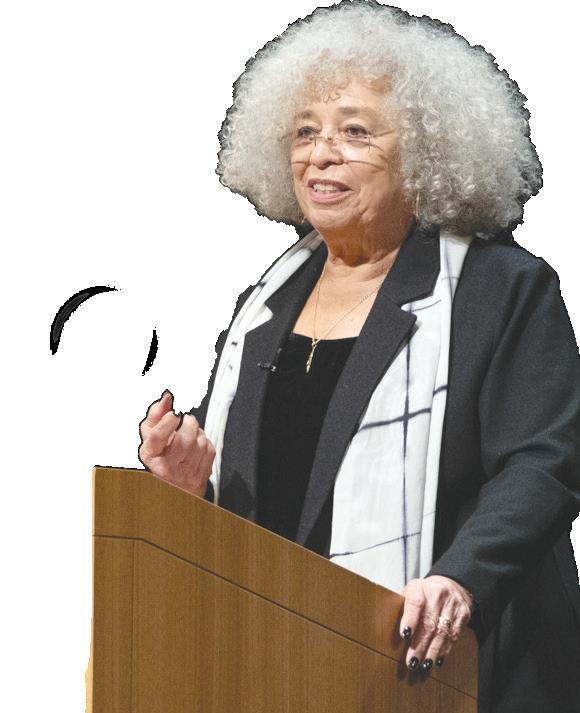
Israel and Palestine and the renewed need to stand up for social justice issues in the United States. Davis emphasized that the struggle for freedom is a “collective practice” and the importance of women — especially Black women — and queer people in the fight for freedom.
“It’s about recognizing the power, the power that we can generate,” Davis said.
Davis spoke extensively about her work as a Palestinian solidarity activist. In response, the audience broke out in cheers of “Free, free Palestine,” which Davis encouraged and joined.
She referred back to her time as a student at Brandeis University, where her Palestinian activism started. She congratulated Cornell activists for their continued critique of “the anti-democratic forces of the State of Israel,” despite the “banishing” of protestors.
Regarding Trump’s victory in the election, Davis said, “We will not be complicit in the kind of fascist program he’s trying to place [in the United States].”
To continue reading this article, please visit www.cornellsun.com.
5 p.m., SundayTursday.
SEND A FAX (607) 273-0746 THE SUN ONLINE www.cornellsun.com E-MAIL sunmailbox@cornellsun.com 139 W. State Street, Ithaca, N.Y. VISIT

Tatkon Workshop: Tatkon Start Strong
7 p.m. - 8 p.m., 103/105 Robert Purcell Community Center
Spring Housing Selection for Rising Sophomores Q&A
8 p.m. - 9 p.m., Unit 1 Lounge Balch Hall
Dragon Boat Club at Cornell Information Session 5 p.m. - 6 p.m., 236 Goldwin Smith Hall
Delta Kappa Alpha Virtual Information Session
6 p.m. - 7 p.m., Google Meet link on CampusGroups
Sustainability Club Discovery Night
6 p.m. - 8 p.m., G155 Martha Van Rensselaer Hall
Food Recovery Network at Cornell G-Body 6 p.m. - 7 p.m., Rockefeller Hall
Engineering Study Abroad Information Session 4 p.m. - 5 p.m., 165 Olin Hall
Chats in the Stacks, Expanding Verse: Japanese Poetry at the Edge of Media
4:30 p.m. - 5:30 p.m., 107 Olin Library
Virtual University-Wide Spring Career Fair 2025 12 p.m. - 4 p.m., Register on Handshake

Society of Asian Scientists and Engineers at Cornell Boba Fundraiser
p.m. - 6 p.m., Duffield Workday Table
Society for Natural Resources Conservation G-Body (Tote Bag Decorating)
5 p.m. - 6 p.m., 236 Goldwin Smith Hall
American Red Cross at Cornell Information Session
5 p.m. - 6 p.m., 230 Rockefeller
Habitat for Humanity Cornell Chapter G-Body 5 p.m. - 6 p.m., 254 Uris Hall
Cornell Prelaw Program in Paris Virtual Information Session
6 p.m., Zoom link in Cornell events listing Women’s Law Coalition G-Body 5 p.m. - 6 p.m., TBD
Cornell Film Club Screening: The Elephant Man (1980)
7:30 p.m. - 10:30 p.m., B21 Schwartz Performing Arts Center

As prelim season looms, students take advantage of the numerous diverse libraries, study halls and improvised study spots at Cornell
By SUN PHOTOGRAPHY DEPARTMENT
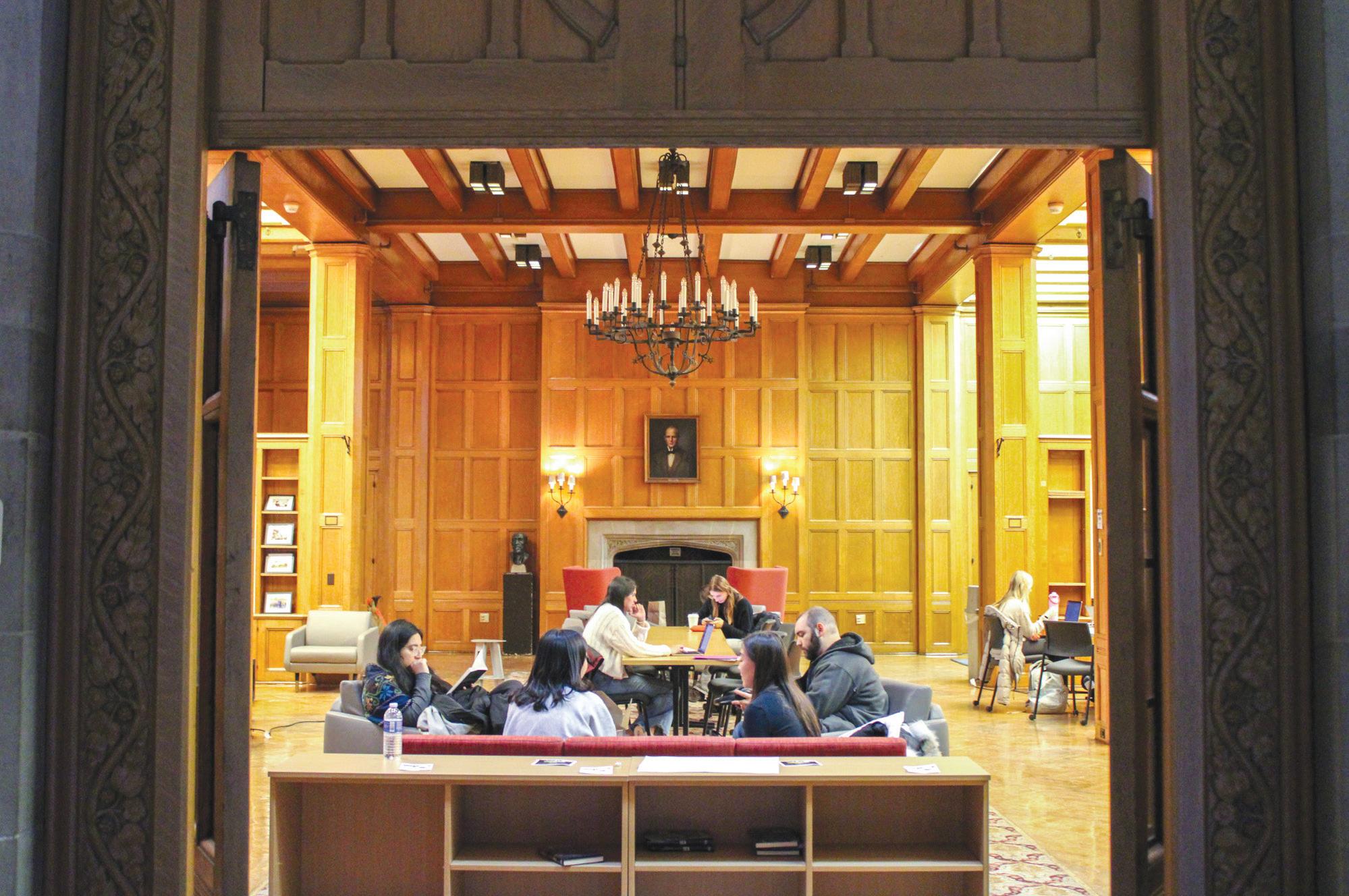


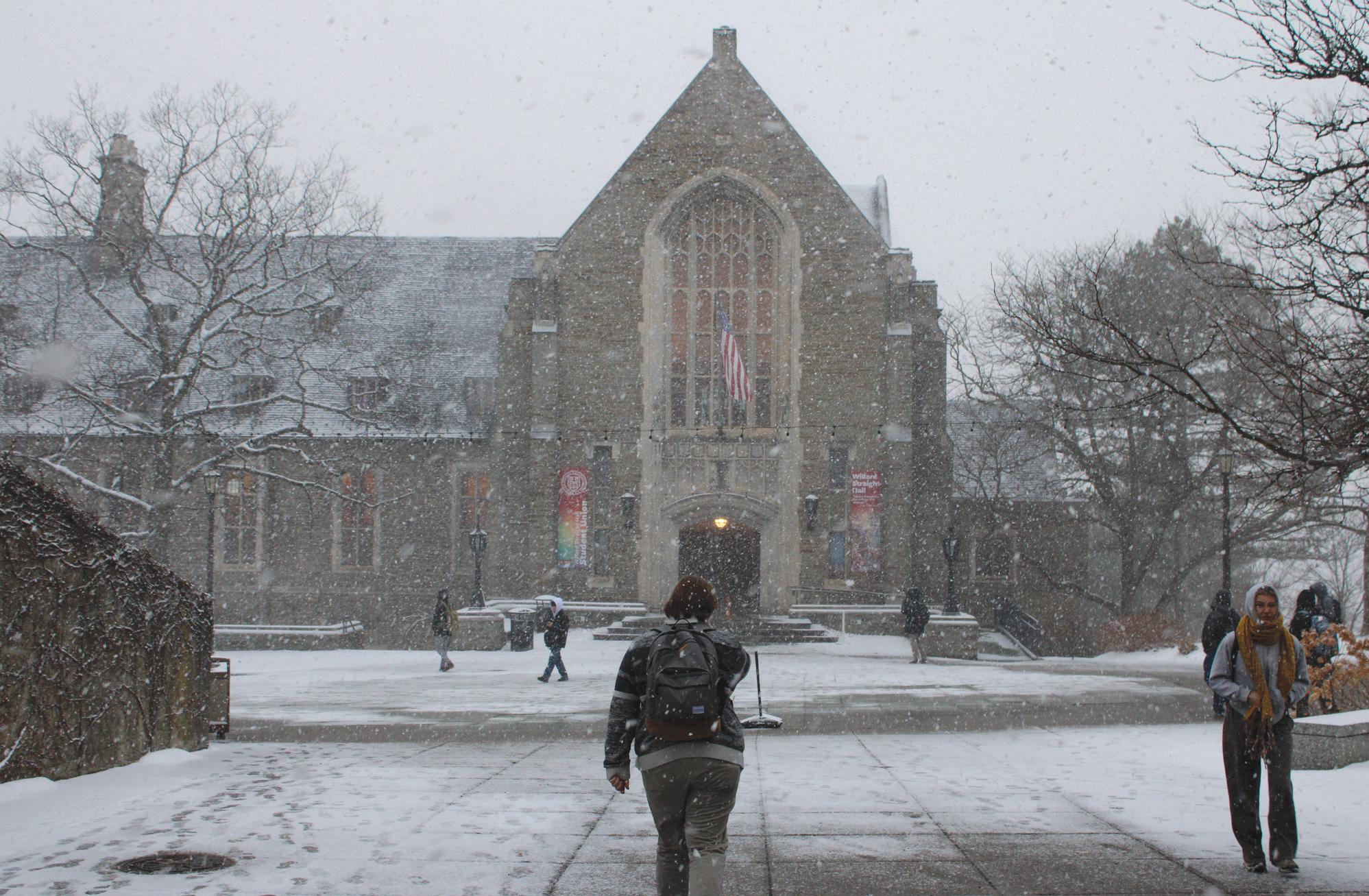
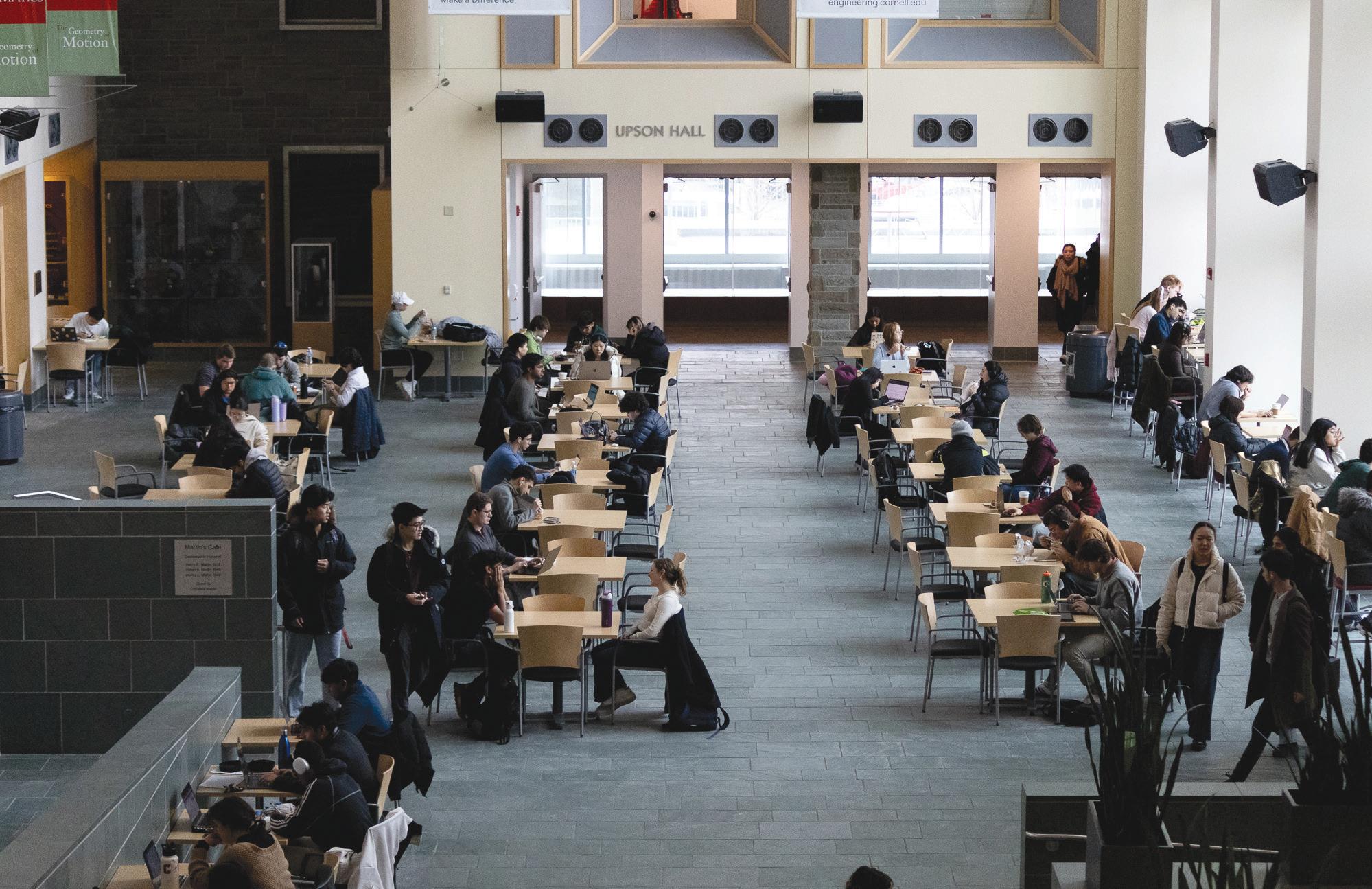
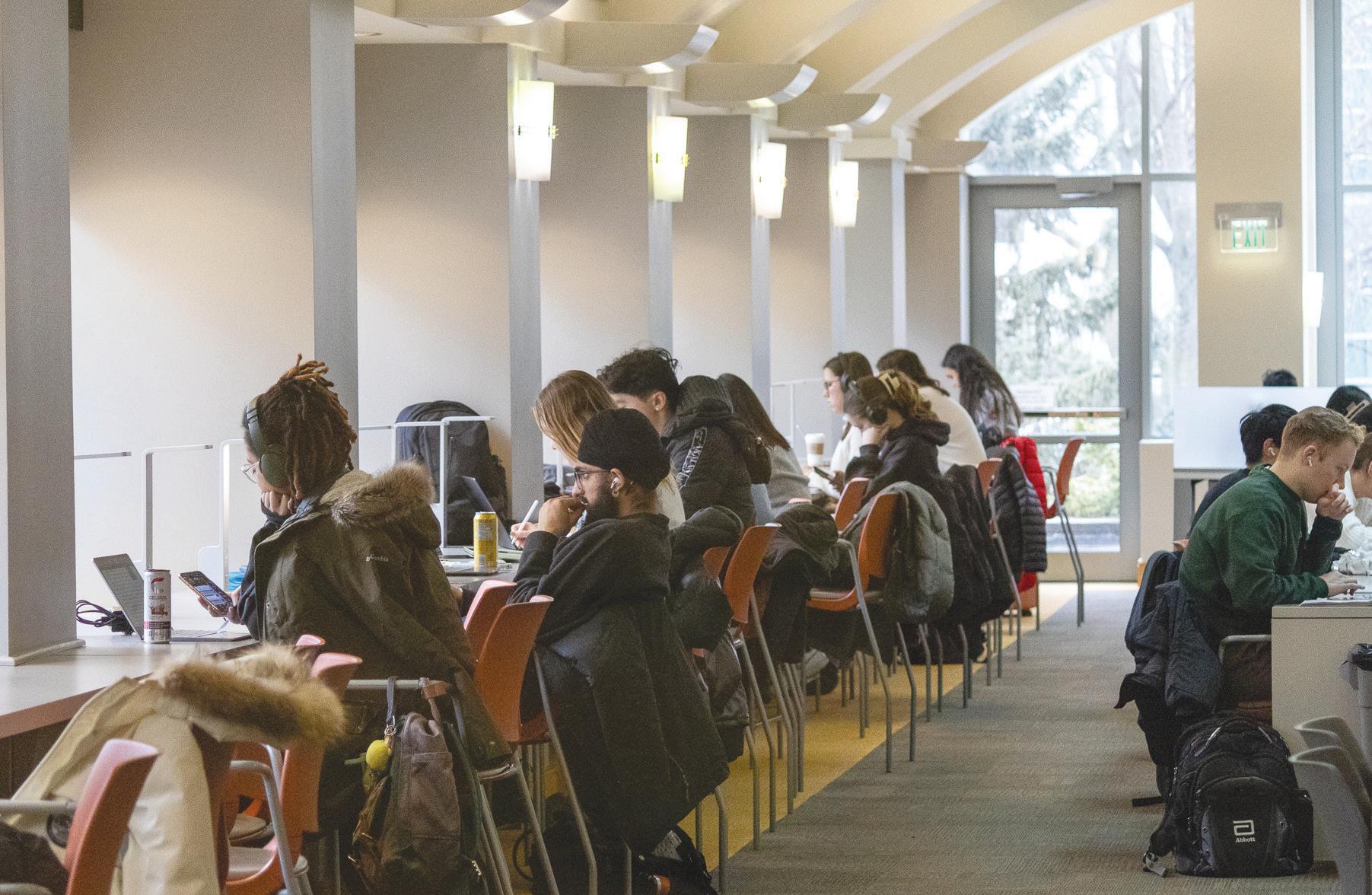

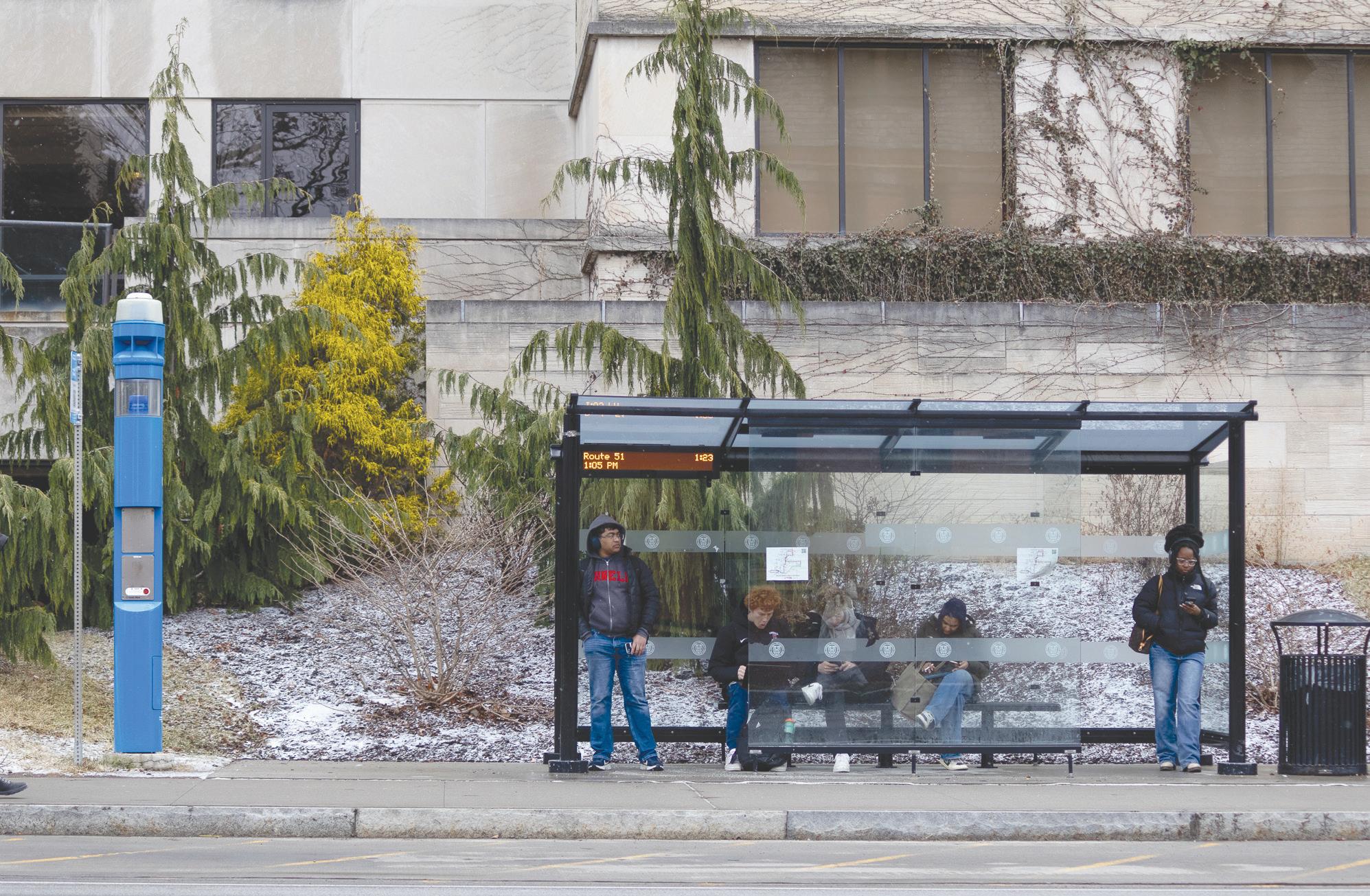
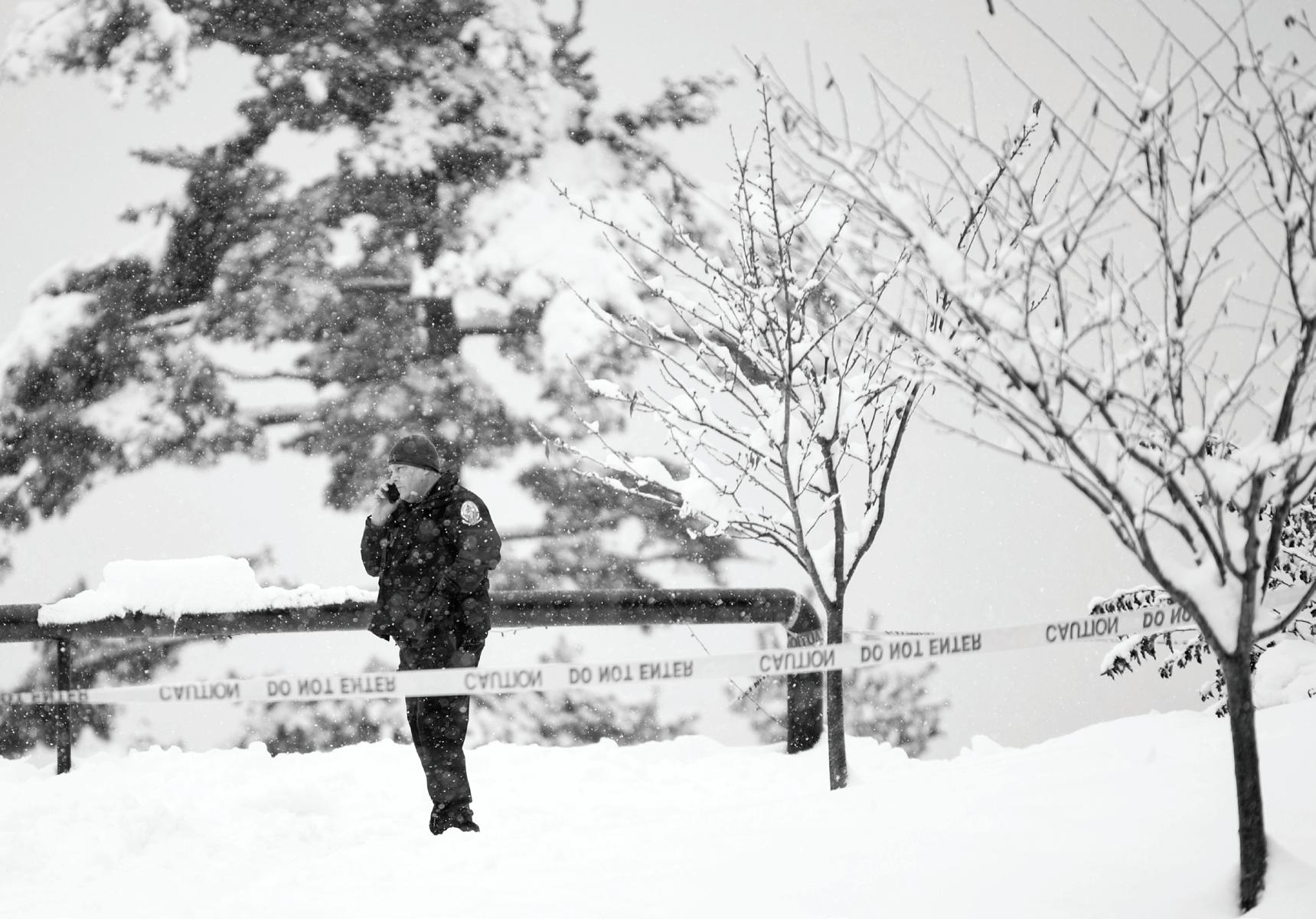
By MARYAM ISMAIL AND MAYA SCHMALING Sun Staff Writer and Sun Contributor
On Thursday, U.S. Immigration and Customs Enforcement agents arrested a man in downtown Ithaca. Now, the University is circulating protocols on how faculty and faculty and staff should handle potential interactions with external law enforcement.
The document acknowledges a commitment to adhering to applicable federal, state and local laws while “providing a welcoming environment for students, staff and faculty.”
The first protocol states: “Be calm and courteous; do not take any action that could be perceived as interfering with an officer’s official duties. If you attempt to actively interfere, physically or otherwise, with the actions of an officer, you risk being subject to criminal prosecution.”
The document states that external law enforcement agents, such as ICE, generally do not have permission to search University areas or access student information without “valid legal authorization.” Faculty and staff can not grant access without permission from the Cornell University Police Department and/or the Office of General Counsel.
If presented with documents including a subpoena or warrant, faculty and staff should immediately contact the CUPD — who will pass along the information to OGC — according to the document. Within the University, only members of the CUPD and OGC have the authority to review and validate subpoenas, warrants, requests or other documents the external law enforcement officer may present.
In his second term, President Donald Trump has intensified immigration regulation, with ICE arresting thousands of migrants since his inauguration.
The Trump administration rescinded guidelines that had previously barred immigration enforcement actions in “sensitive areas” including schools, churches and college campuses, escalating concerns among undocumented individuals.
In an email to University staff and students, Interim President Michael Kotlikoff acknowledged the “significant concerns felt by immigrant and undocumented members of our community.”
“Cornell remains committed to continuing its support of all members of the university community,” Kotlikoff wrote. “We will comply with university policy and federal law regarding the protection of sensitive personal information.”
ICE has the legal authority to be in public areas without permission. However, Prof. Jaclyn Kelley-Widmer, law — who specializes in immigration and asylum law — clarified that there is no reason to expect an on-campus ICE raid.
“There have been very few incidents of ICE on campus in the last decade or more,” Kelley-Widmer wrote in a statement to The Sun. “We don’t have any particular reason to expect ICE on campus now.”
The Family Educational Rights and Privacy Act protects the personally identifiable information of undocumented students and Deferred Action for Childhood Arrivals recipients.
“Cornell remains committed to continuing its support of all members of the university community,” a University spokesperson wrote in a statement to The Sun. “We will comply with university policy and federal law regarding the protection of sensitive personal information.”
Furthermore, a CUPD policy adopted in 2017 outlines the limitations on officers’ role in federal immigration enforcement. The policy states that CUPD officers should not enforce federal immigration law or arrest individuals based solely on their actual or suspected citizenship status.
According to the policy, the Cornell University Police Department “should not honor ICE or [U.S. Customs and Border Protection] requests for certain non-public, sensitive information about an individual” unless compelled by a judicial warrant.
Absent a judicial warrant, CUPD can comply “affirmatively” with ICE detainer requests to detain an individual only if there is “probable cause to believe” an individual has re-entered the country unlawfully after removal or has been convicted of a serious crime — including Class A or Class B felonies.
Kelley-Widmer emphasized that students approached by ICE officers have constitutional rights that they should remain aware of and exercise if needed. Individuals have a Fifth Amendment right to remain silent and are not required to answer questions from ICE officers.
Kelley-Widmar encourages every community member, if approached by external law enforcement, to contact the Cornell Public Safety Communications Center at 607-255-1111 or use the RAVE Guardian app and request that CUPD respond.
By EMMA GALGANO Sun Contributor
Feb. 3 — President Donald Trump’s recent executive orders aiming to curtail diversity, equity and inclusion initiatives have sparked concern about the future of DEI programs across higher education institutions in the United States, including at Cornell.
On Jan. 20 and Jan. 21, Trump signed executive orders eliminating DEI programs at federal funded institutions. The orders specifically call for investigations into the DEI programs of universities with endowments exceeding $1 billion — which includes Cornell.
If Cornell fails to comply with these orders, the University could face the loss of substantial federal funding through grants in contracts.
In the 2023-2024 academic year, Cornell received $157 million in state and federal funding for research, grants and student scholarships.
According to Cornell’s DEI glossary, DEI initiatives aim to create an inclusive and supportive environment by promoting diversity across various dimensions such as race, gender and socioeconomic background. These initiatives include the Belonging at Cornell framework, mandatory staff training and specialized resources like the Center for Racial Justice and Equitable Futures to support academic diversity and inclusivity.
When asked about their plans to address Trump’s actions regarding DEI, a University spokesperson reiterated a previous statement to The Sun regarding the University’s response to Trump’s executive orders.
“University leadership continues to evaluate how new executive orders affect our community. As more concrete information becomes available, we will provide guidance on how the executive orders and other directives may impact our programs and community members,” the spokesperson wrote.
However, the University declined to answer questions on how they will navigate the tension between DEI commitments and the risk of losing federal funding and how they plan to support students and faculty who may be impacted by the reduction or elimination of DEI programs.
In response to Trump’s executive orders, many universities — including Northeastern University and Rutgers University — have modified DEI programming.
On Tuesday, Cornell launched a website providing information on Trump’s
executive orders and other new federal policies, along with an email address for students to ask questions and share feedback.
Prof. Randy Wayne, plant science, who has written several anti-DEI articles for The New York Post and The College Fix, called Trump’s executive orders “wise advice.”
Wayne said that Cornell is “radicalizing” students and that DEI initiatives prioritize certain issues while silencing others, thereby limiting the scope of discussion.
“You’re not becoming wise at Cornell. You’re really becoming stupid. We’re educating people into imbecility,” Wayne said.
However, Niles Hite ’26, vice president of finance for the Student Assembly and president of Cornell Democrats, argued that DEI programs are vital to the intellectual growth of students.
“All the people here at this university come from different backgrounds and different places. It’s not just about skin color, … but it’s about differences in income, parents’ jobs, where people live, political affiliations and skills,” Hite said. “That diversity is really important. To take that away in an academic setting, where we’re here to learn, challenge ourselves and think outside the box, is a big mistake.”
Adam Vinson ’25, executive vice president of the Student Assembly, said that he hopes Cornell will stand firm in the face of these changes.
“I do hope that we at Cornell have a stronger backbone than the other universities that are cutting programs and just giving up,” Vinson said.
Hite said he wants to see the University take further action, starting with a formal statement that condemns the Trump administration from Interim President Michael Kotlikoff, since he believes the Trump administration is undoing values Cornell claims to uphold.
Vinson echoed this belief, emphasizing the importance of fighting against Trump’s executive orders.
“It’s just four years — I think we can push back against this, and if there’s no pushback, then they just succeed,” Vinson said. “What we do at Cornell, even on a small scale, has a national impact. If we want a better world — whether for environmental issues or DEI initiatives — we have to push back.”
By GABRIEL MUÑOZ and AVERY WANG
Jan. 30 — U.S. Immigration and Customs Enforcement agents arrested 27-year-old Jesus Romero-Hernandez in downtown Ithaca on Thursday afternoon, according to a press release by the U.S. Department of Justice.
Romero-Hernandez, a Mexican citizen, was charged in a federal criminal complaint issued on Jan. 8, 2024, for illegally re-entering the United States after a prior removal.
According to The Ithaca Voice, inmate records indicate that Romero-Hernandez had been held at the Tompkins County Jail since Sept. 28, 2023, over New York State third-degree assault charges. However, his charges were resolved on Tuesday after he pleaded guilty and was sentenced to time he had already spent in the county jail.
Since he was in the custody of the Tompkins County Sheriff’s Office at the time, ICE Enforcement and Removal Operations sent a copy of the federal arrest warrant to the Tompkins County Sheriff’s Office, according to the DOJ statement.
The DOJ wrote that the Tompkins County Sheriff’s Office “refused to honor the federal arrest warrant” by releasing Romero-Hernandez before ICE-ERO arrived to bring him to federal court in Syracuse, where he would be arraigned on the federal criminal complaint.
“The Tompkins County Sheriff’s Office in Ithaca, NY, a self-described sanctuary city, appears to have failed to honor a valid federal arrest warrant for a criminal alien with an assault conviction,” Acting Deputy Attorney General Emil Bove wrote in the DOJ press release. “Yesterday, despite the warrant, a defendant with no legal status and a history of violence was released into the community.”
“The Tompkins County Sheriff’s Office in Ithaca, NY, a self-described sanctuary city, appears to have failed to honor a valid federal arrest warrant for a criminal alien with an assault conviction.”
Acting Deputy Attorney General Emil Bove
As a sanctuary city, the Ithaca Police Department operates under stringent regulations on how they can respond to federal requests relating to undocumented individuals residing in the city.
ICE-ERO carried out the arrest with assistance from the U.S. Marshals Service and Homeland Security Investigations, according to the DOJ statement. New York State Police Troop C wrote in a statement to The Sun that they were “an assist-
ing agency” in the arrest but said they would not answer further questions as they were not the lead agency in the investigation.
City officials published a statement on Thursday that the local police forces did not cooperate with the investigation because of Ithaca’s status as a sanctuary city.
“The City of Ithaca has been made aware that federal law enforcement conducted operations in Ithaca today in connection with federal warrants,” the statement read. “The Ithaca Police Department adhered to all relevant City policies, including Ithaca’s Sanctuary City policy (Article VI of Chapter 215 of the Ithaca City Code), in consultation with the City Attorney and City Manager’s office.”
Ithaca passed sanctuary city legislation on Feb. 1, 2017. The Common Council reaffirmed its commitment to its status and duties as a sanctuary city on Jan. 22.
“We will use every tool at our disposal to prevent sanctuary city policies from impeding and obstructing lawful federal operations designed to make America safe again...”
Acting Deputy Attorney General Emil Bove
A spokesperson for the University wrote to The Sun that the University remains committed to supporting all community members. However, they did not answer whether or not ICE agents would be permitted on campus.
“Cornell remains committed to continuing its support of all members of the university community. We will comply with university policy and federal law regarding the protection of sensitive personal information,” the statement read.
The Ithaca arrest follows a series of immigration raids across the country where thousands of migrants have been arrested, 11 days into President Donald Trump’s second term.
“The Justice Department will not tolerate actions that endanger law enforcement and make their jobs harder than they already are,” Bove said. “We will use every tool at our disposal to prevent sanctuary city policies from impeding and obstructing lawful federal operations designed to make America safe again and end the national crisis arising from four years of failed immigration policy.”
The Tompkins County Sheriff’s Office did not respond to multiple requests for comment.
Gabriel Muñoz can be reached at gmunoz@cornellsun.com and Avery Wang can be reached at ahw83@cornell.edu.

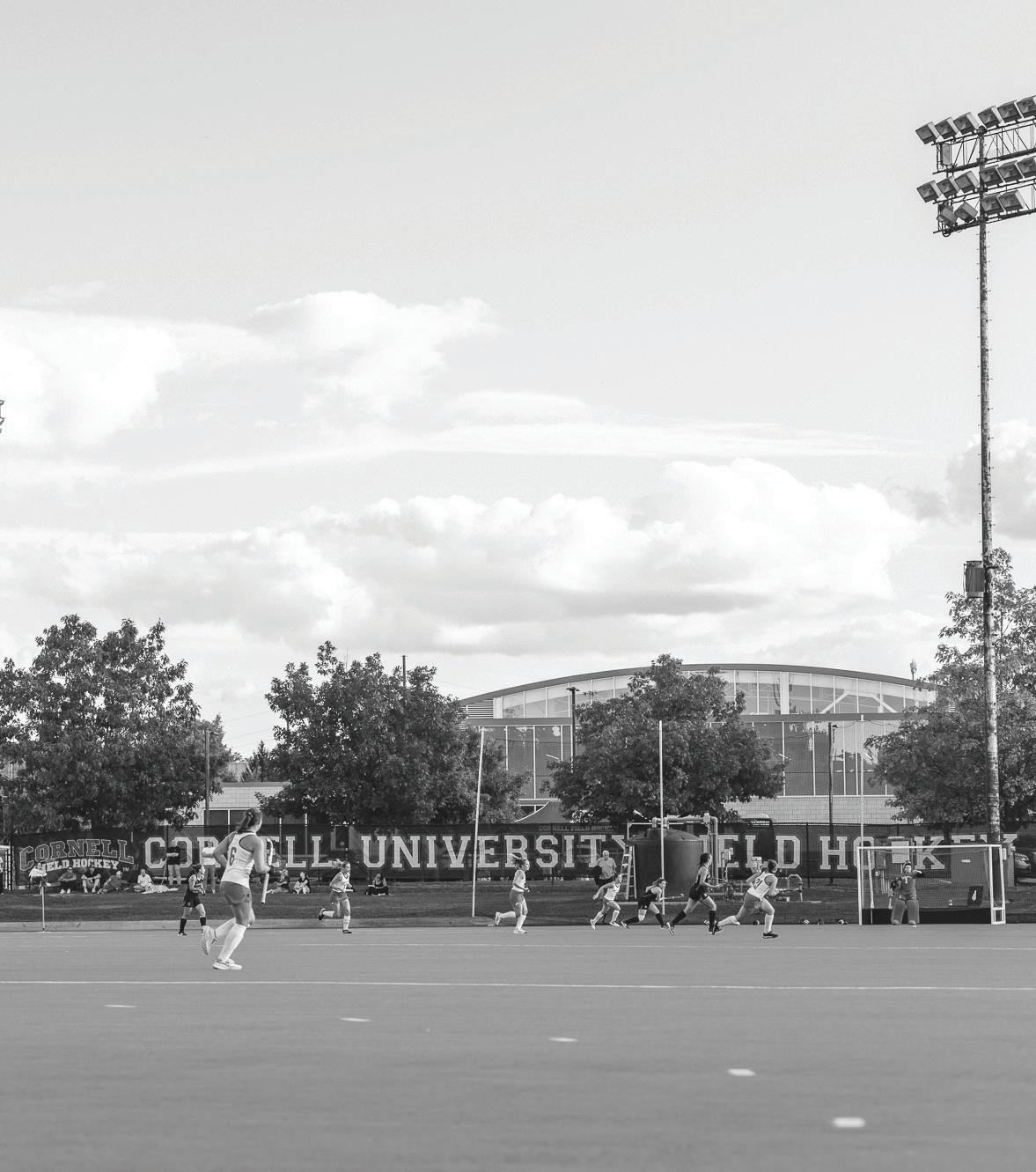
a formalized 120-space parking area for fans, coaches and players.
Jan. 29 — As Cornell’s field hockey team looks forward to the 2025 fall season, the future remains unknown due to renovation setbacks that may leave the team without a home field.
Field hockey’s original home field, Marsha Dodson, was destroyed as part of a project to make an artificial turf field, among other improvements. However, according to a statement from Athletic Director Nicki Moore, the timeline of this project — dubbed “Game Farm Road” — has been delayed.
Moore revealed in a recent statement that “recent municipal efforts have delayed [the] project timeline,” and ultimately jeopardized the team’s game and practice space. Moore apologized for “not offering adequate communication” in sharing developments with the field hockey community and for not “listen[ing] to [her] project team colleagues when they warned [her] of growing timeline risks.”
This delay follows a series of complaints about environmental concerns from Ithaca residents.
The next closest NCAAregulated field hockey pitch is located 52.2 miles off campus in Syracuse, posing challenges for the next season. For a team that was nationally ranked No. 16 in 2023 and played some close and thrilling games on Marsha Dodson Field last fall, this comes as very disappointing news.
Cornell’s plan for Game Farm Road’s new athletic complex was published in June 2015 and was set to be completed before the beginning of the Fall 2025 semester.
The stadium was set to be located on 15.65 acres in the Town of Ithaca, east of McGovern Fields. The project was also going to include other improvements, including a state-of-the-art drainage system, coaches’ offices, a new press box, a team facility and
The plan was divided into two phases: first, the field hockey pitch would be constructed with synthetic turf. Along with the new turf, two buildings containing restrooms and a press box, a 10,000-gallon water storage tank for field irrigation and two team dugouts were to be constructed.
The second phase of the plan included a larger building that would hold offices, meeting rooms, a team locker room, a physical training room and a small indoor practice space which would also use synthetic turf.
In August 2024, Prof. Frank S. Rossi, plant science, made a statement to the Ithaca Planning and Development Board conveying his belief that, although the natural grass field would have been best for the environment, the “lack of available playing surfaces on campus” created a unique demand that only a synthetic turf surface could keep up with.
The turf met all of the relevant New York State Environmental Conservation Laws and was to be reused and recycled until the end of its typical eight to twelve-year life span.
Despite Rossi’s statement and the turf’s compliance with New York State law, citizens of Ithaca listed out many environmental concerns in email complaints to the Town of Ithaca Planning Board. Concerns included worries about air, water and soil contamination, disposal of the artificial turf and microplastics carried by wind into water systems — which have the potential to harm the surrounding ecosystem.
The field hockey team currently uses the indoor turf in the Ramin Room for their spring practices, but they will be unable to compete here formally, as the space does not comply with NCAA standards.
GABRIEL LEVIN ’26
Editor in Chief
MAX FATTAL ’25
Associate Editor
HENRY SCHECHTER ’26
Opinion Editor
MARIAN CABALLO ’26
Multimedia Editor
MING DeMERS ’25
Photography Editor
ERIC HAN ’26
Arts & Culture Editor
SYDNEY LEVINTON ’27
Arts & Culture Editor
JADE DUBUCHE ’27
Social Media Editor
JESSIE GUILLEN ’27
Graphics Editor
JOLIN LI ’27
Layout Editor
PARIS CHAKRAVARTY ’27
Layout Editor
LEILANI BURKE ’25
Assistant Photography Editor
KARLIE McGANN ’27
Assistant Photography Editor
KIRA WALTER ’26
Lifestyle Editor
DANIELA ROJAS ’25
Assistant Lifestyle Editor
NICOLE COLLINS ’25
Weather Editor
JULIA SENZON ’26
Managing Editor
ERIC REILLY ’25
Assistant Managing Editor
MARISA CEFOLA ’26 News Editor
MATTHEW KIVIAT ’27 News Editor
CHRISTINA MacCORKLE ’26 News Editor
DOROTHY FRANCE-MILLER ’27 News Editor
JANE McNALLY ’26
Sports Editor
GABRIEL MUÑOZ ’26 City Editor
KAITLIN CHUNG ’26 Science Editor
LAINE HAVENS ’25
Science Editor
ANUSHKA SHOREWALA ’26
Assistant News Editor
OLIVIA HOLLOWAY ’25
Assistant News Editor
DINA SHLUFMAN ’27
Assistant News Editor
ALLISON HECHT ’26 Newsletter Editor
JENNA LEDLEY ’27 Assistant Arts Editor
Niles Eldredge is Curator Emeritus in the Division of Paleontology at Te American Museum of Natural History.
Iwrite today to urge a strengthening of support by Cornell University for the Paleontological Research Institution on Trumansburg Rd. in Ithaca. I have visited and delivered lectures at both institutions many times over the past 60 years. I have long recognized Cornell as the truly great educational and scholarly research institution it has always been. I see the PRI as a vital, thoroughly modern world-class research and educational system that is vital to the preservation and dissemination of knowledge on the history of life. In an age fraught with misinformation, living as we do in a society utterly dependent on the current high state of scientific knowledge and ongoing research, it is vital to our national interests to keep such institutions up and running and fully functional.
So much is well-known. I am further motivated today by the Cornell student, Emily Cavanaugh, who has brought the plight of PRI to the Cornell community at large, as well as to me personally. Emily is the very embodiment of why PRI is so important to Cornell. She first contacted me about some unusually important fossils she discovered, and now studies for an honors thesis. I based the theory of punctuated equilibria (Eldredge and Gould, 1972) mainly on my research on the Middle Devonian trilobite Eldredgeops rana. I have encountered only a very few specimens of these trilobites younger than the ones I collected in South Lansing. All have turned out to be so poorly preserved as to be unidentifiable. Emily Cavanaugh’s Ithaca Shale fossils are in the Upper Devonian. She is on the verge of determining whether her specimens represent the dramatic survival of the last known species, or whether indeed the stock persisted through another evolutionary event, when most of the rest of the fauna became extinct.
We are living in an age when the reality of mass extinctions is becoming personal: we are in the early stages of the Sixth Extinction. The survival of Earth’s living species — including ourselves — is at stake. Emily’s work on what really happened to this lineage of trilobites is vital to understanding the dynamics of the extinction process and the degree to which evolution provides a potential “escape valve” to the future.
In her opinion piece, Emily writes trenchantly and poignantly describing how her passion, motivation and early hands-on training have depended crucially on her PRI experiences — including tutelage by Warren Allmon, Director of PRI, and himself a distinguished paleontologist. Without PRI, ambitious students like Emily would lose an important educational resource. I urge Cornell to examine the nature of its support for PRI — with the knowledge that its work is more vital than ever for the insights it can give us for the potentially catastrophic ecological future the species of our planet currently face.
To continue reading, visit www.cornellsun.com.
Karim-Aly Kassam is a professor in the Department of Natural Resources and the Environment & American Indian and Indigenous Studies.
Last week was breathtaking. On Monday, Jan. 27, $1 trillion was shaved off the stock market in a single day. By Thursday, Jan. 30, Federal Law Enforcement was in the Ithaca Commons, raising real concerns among young scholars (including Native American Students) because of their complexion, that they would be profiled and questioned. Furthermore, these law enforcement actions have an impact on international students because of the President’s executive orders, especially if they were involved in activism. One is left breathless not because of a sense of awe but because of being a witness to sheer callousness and unrestrained inhumanity in the most powerful democracy on the planet.
Our colleagues in astronomy inform us that a star like the sun, as it approaches its death, begins to supernova. It becomes larger and larger while it uses up all its energy as it burns life in its explosive wake. Then after some time, having been spent, it collapses. The current moment in our history can be likened to a supernova. To be sure, this political process has also been aided by forces on the other side who claim the moral high ground, but their protestations are a façade. Both sides are objective allies and need each other to justify their own existence. If you view them from a distance, as my work with Indigenous peoples in the Circumpolar Arctic, the Northern Forest and the Mountains of Central Asia has allowed me to do, you will notice there is very little difference among them because they are both driven by ill-conceived self-righteousness and a monolithic conception of their own truth. They do not know how to doubt and engage in critical self-examination. Despite being well endowed with privilege, a bounty of benefits, and vast financial resources, both sides present themselves as “victims.” Thus, making us, the silent majority, “victims of victims.”
So, what are scholars, students and faculty alike, to do? Like the Indigenous peoples I work with, we are not just victims, we have agency. I would argue, it is to protect pluralism because difference matters!
Difference is so fundamental that the capacity to perceive it is shared by all living organisms from the worm to the human. We need differences to discern. It is the basis of knowledge itself because difference helps us learn. In essence, difference sustains life. This cognitive diversity is the source of pluralism: A value that protects difference.
Valuing difference is not just about appearance but ways of knowing. Pluralism in our way of being (ontology) and our thinking (epistemology) is key to addressing the climate crisis. Pluralism is vital to achieving food sovereignty and the outcome of food security. It is fundamental to overcoming poverty traps. Pluralism is necessary for attaining environmental justice and preventing violence performed against human beings of different ideological,
ethnic, religious and sexual orientations. What we do to our land and seascapes, we also do to each other; and what we do to each other, we also do to our land and seascapes. Together, this has implications for future generations of all life. If we eliminate difference, we promote the “death of birth.” These are the basic precepts of environmental justice.
Even those who worship Mammon, the demon of greed, realized last week through international stock markets that pluralism is also key to the development and ethical governance of artificial intelligence. American-based companies lost billions as they discovered that their arrogance and self-assuredness did not account for other ways of doing and thinking regarding artificial intelligence.
So, what do we do when we are caught in a historical moment like a political supernova? We build institutions, intellectual infrastructure and community engagement that facilitate and nurture pluralism. International studies of specific regions and societies, language studies beyond just the romance languages and investment in Indigenous languages and cultures are the bulwark, evolving in the present to meet the needs of future scholars and policy-makers. We cannot be distracted by background noise, of which, both sides among the elite oligarchies are spewing. Quietly, wisely and effectively, we must continue without drawing too much attention to our work. We do not need academic prima donnas; their commitment is weak because of shameless self-promotion and their intellectual depth is shallow because it is not able to embrace the value and insight of the “other.” Academic titillation and shock and awe are not our tactics. We need to speak truth to power with humility and grace, and that requires stamina, the ability to doubt along with conviction and cognitive diversity. In short, pluralism.
History shows us that no system based on self-deception, fear and motivated by hate can sustain itself over a long period of time because it will cannibalize itself. The supernova is temporary, and it will end. Meanwhile, we will be present and engaged. This is the time not only to dream dangerously but to act strategically with tactics that conserve difference. Pluralism opens up possibilities for action in resolving the climate crisis, eliminating poverty traps, achieving environmental justice, creating mutual understanding and engaging a free society of the twenty-first century.
Carlin Reyen is a third year student in the College of Arts and Sciences. Her fortnightly column Just Carlin’ It Like It Is centers around student life, social issues, Cornell life hacks and the university’s interactions with the broader community. Carlin can be reached at creyen@cornellsun.com.
When the TikTok ban went into effect on Jan. 19, blocking app service to American users, I was excited. Not because I enjoy being a contrarian—in fact, I like a lot of Taylor Swift’s music—but because I believe TikTok is setting our generation back.
Putting the issue of national security aside, a topic that deserves an entire column in and of itself, I have a few qualms with the app from personal experience.
To me, TikTok is reminiscent of pandemic escapism, a time when the inability to socialize in public was replaced by seemingly never-ending free time. And it serves as just that: a time waste and a distraction from real-world interaction and community building.
First of all, I despise how humor is becoming increasingly referential. Instead of creative jokes, young adults are relying more and more on joke trends, which follow a pre-existing format to farm cheap laughs (and clicks). While there are certainly novel creators getting their start through cultivating channels of loyal viewers whom I commend, I can’t help but feel that overall, TikTok homogenizes humor in a way that reduces independent thought. A formative part of my adolescence was coming up with little inside jokes with my friends and using my imagination. I worry that the replacement of entertainment with video content at early ages will completely stifle youthful creativity and independent thought.
And it’s not just humor that has become standardized; the micro-trends circulating TikTok make everyone dress the same as well as talk the same. Ultimately, TikTok influencer culture promotes excessive consumerism. TikTok trends and the in-app TikTok Shop encourage fast fashion consumption and turnover at a rate exceedingly harmful to our already fragile environmental context, and what’s more, they stamp out any semblance of originality among our generation. Furthermore, short-form content is completely decimating Gen Z attention spans. No longer can America’s youth sit through a full-length movie without the accompaniment of an occasional — or continuous — doomscroll on TikTok. Moreover, I’ve noticed that my friends and I often have entire conversations without lifting our gazes from our screens. Anecdotally, shortform content also makes it a lot more difficult for screen-less activities to seem fun anymore, heightening the expectation for instant gratification in every aspect of our lives.
It’s no wonder—the app optimizes for two main factors in its algorithm: “retention” (whether or not a user returns to the platform) and “time spent” (how long a user
spends on the app per session). Consequently, rewarding users’ brains with instant dopamine release is certainly critical to a business model like this one, and users our age buy in, with an hour on average spent on the app per day. TikTok and other social media apps affect addiction pathways in the developing brain in the same way that alcohol and drugs do. The app can become addictive after just 35 minutes of use, according to internal communications between TikTok executives.
Making matters worse, with the desired goal of retention, the algorithm creates echo chambers of similar material, making it incredibly easy for users to fall into traps of misinformation, without the existence of diverse viewpoints. I’ll be honest: I’ve caught myself neglecting to check the sourcing of a piece of information after hearing it on TikTok. Nowadays, everything is seen as true: broadcast to a captive audience without any guardrails separating fact from fiction. Let’s face it: TikTok throws content at young brains with no incentive to validate the content being shared. Young people are being fed skewed or false news, self-diagnosing with medical disorders and just generally getting manipulated.
“To me, TikTok is reminiscent of pandemic escapism, a time when the inability to socialize in public was replaced by seemingly never-ending free time. And it serves as just that: a time waste and a distraction from real-world interaction and community building.”
Our generation is desensitized to voluntarily sharing personal information on the internet. All occasions, from life milestones to travel, to death, health issues and trauma, are documented daily and published by our peers for the world to see. My mother raised me to beware of sharing personal information with strangers online. Now, it seems it is normal to divulge private information to strangers online for what is quite literally 15 minutes of fame.
While some may argue that TikTok allows for organic small business growth and independent content creators to develop, the app is also holding back so many young minds from being creative and original by trapping them in their screens indefinitely.
Banning TikTok gave us a brief glimpse of what it would be like to set Gen Z free. I’d be happy to see the ban return, this time for good.
Rosemary Batt is a Professor Alice H. Cook Professor of Women and Work in the School of Industrial Labor Relations. She can be reached at rb41@cornell.edu.
On Thursday night, Interim President Michael Kotlikoff and newly appointed Provost Kavita Bala emailed the campus community with a University statement accusing the Cornell Graduate Student Union-United Electrical, Radio & Machine Workers of America, or CGSU-UE, of bargaining for a provision that would harm graduate students.
President Kotlikoff and Provost Bala’s Statement was wrong on the facts and wrong on the law. As School of Industrial and Labor Relations faculty experts in labor law and labor relations, we feel it is our duty to explain why.
President Kotlikoff and Provost Bala wrongly stated that under the CGSU-UE’s union shop proposal, “students who decline to join the union could be dismissed from their appointments and prohibited from holding future appointments. These students would no longer have a viable path to a degree at Cornell. Under the proposed union shop agreement, there is no option for students to remain graduate assistants if they object to joining the union.”
Here’s why President Kotlikoff and Provost Bala’s statements were wrong on the facts and the law: The CGSU-UE has proposed a lawful “union shop” provision, which is a “union security” clause that provides that all employees covered by a collective bargaining agreement will become union members, but that only payment of union dues is a condition of employment. In other words, under the CGSU-UE proposed union shop provision, no graduate employee can be dismissed for refusing to become a union member. Under the terms of the proposed union shop clause, only payment of dues (often referred to as an “agency fee”), is a condition of employment as a teaching or research assistant. This is standard and lawful language, and not an extraordinary request.
The CGSU-UE’s proposed union shop clause is lawful under the National Labor Relations Act, which protects private sector employees’ rights to unionize and collectively bargain. Under the NLRA, all employees in the bargaining unit of Cornell Teaching and Research Assistants will be protected by the collective bargaining agreement negotiated by the CGSU-UE. All teaching assistants and research assistants, whether or not they are union members, will benefit equally from the collective bargaining agreement’s provisions for wages, insurance, safety provisions, anti-discrimination protections, union representation in grievance processes and other workplace improvements. Therefore, it is only fair that all employees in the bargaining unit should also pay their share of the costs of collective bargaining, contract enforcement and grievance handling. This strengthens workers’ power, which is the express duty of the union. And so, under a union shop clause, all bargaining unit employees pay their
fair share through union dues. Other universities, as well as Cornell’s agreement with the United Automobile Workers Local 2300, have agreed to similar union shop clauses in their collective bargaining agreements with graduate employee unions. This includes some of Cornell’s peer universities such as the Massachusetts Institute of Technology and Johns Hopkins University, in their respective collective bargaining agreements with the GSU-UE and TRU-UE. Union security clauses are standard in collective bargaining agreements between universities and graduate student unions, including University of Chicago’s contract with the GSU-UE, Northwestern University’s contract with the NUGW-UE and Yale University’s contract with Local 33 Unite Here.
Additionally, Cornell President Kotlikoff and Provost Bala wrongly stated, “Accepting a union shop provision would mean requiring every one of our graduate student workers to affiliate with, and financially support, [the UE’s political] advocacy.”
As for why President Kotlikoff and Provost Bala’s statements were again wrong about the facts and the law, since the U.S. Supreme Court’s 1988 decision in Communication Workers of America v. Beck, under a union shop clause, bargaining unit employees who are not union members may object to paying the full amount of union dues. Instead, they will be required to pay only the portion of the union dues used directly for union representation, such as collective bargaining, contract administration and grievance adjustment. That portion of the union dues — by law — excludes union dues pertaining to political activities. How could President Kotlikoff and Provost Bala have been so wrong on both the facts and the law? Surely, the Cornell Administration’s attorneys know better than this, particularly on issues that would be part of a “Labor Law 101” course. Consultation with labor law experts on campus could have illuminated this. The statements were so inaccurate and misleading that they may constitute coercion and bad faith bargaining, which are unfair labor practices under the National Labor Relations Act. Whatever their motivations, President Kotlikoff and Provost Bala’s University statement was unfair and inaccurate. They should correct the record, retract their email and University Statement and apologize to the CGSU-UE, the graduate students and graduate employees as well as the entire campus community.
Signed, Rosemary Batt, Alice H. Cook Professor of Women and Work.
To see all 22 signees, visit www.cornellsun.com.
By TANIA HAO Sun Contributor
A new strategy for identifying manipulative content could help people recognize misinformation by prefacing content with reminders to consider its accuracy, according to a Cornellled study.
Prof. Gordon Pennycook, psychology, is the lead author of the paper “Inoculation and accuracy prompting increase accuracy discernment in combination but not alone.”
According to the paper, which was published on Nov. 4, inoculation is a popular technique that educates people about common manipulation strategies. Inoculation differs from traditional strategies of combating misinformation, such as fact-checking and debunking, as it attempts to deal with misinformation before it spreads.
A 2022 study found that participants who were shown inoculation interventions through educational videos performed better on a subsequent manipulation identification task. After this research was published, social media and technology companies began efforts to scale the approach for a larger audience, the authors wrote.
Pennycook — whose research specializes in human reasoning and decision-making — was inspired by the applications of cognitive psychology in contemporary global issues. Amidst growing concerns about misinformation following the 2016 presidential election, he began researching the cognitive science of misinformation and its intersection with social media.
According to Pennycook, inoculation as a technique to combat misinformation is particularly appealing to social media companies, because “it’s like an educational campaign that doesn’t force them to say anything about what

is true and what is false.”
However, there is no evidence that inoculation improves people’s ability to distinguish true and false content, only that it may enhance people’s ability to identify manipulative content. Skeptical of inoculation as a technique against misinformation, Pennycook and the other authors proposed the experiment and collaborated with two Google researchers to conduct the study on inoculation and accuracy prompting.
In the study, the authors first showed participants a video informing them of the use of emotional language as a manipulation technique. The authors then exposed participants to real news headlines that were either true or false in which they systematically varied the presence or absence of emotional
manipulation.
An example of a false high-emotion headline fabricated by the authors to be used in the study was “Decorated Democrat arrested and charged with 6 heinous crimes,” while the corresponding false low-emotion headline was “A Democrat has been arrested and charged with 6 crimes.”
Participants then indicated the extent to which a random subset of fifteen headlines made them feel emotions, seemed accurate and whether or not they would share the headlines on social media. The first three tests found that inoculation in isolation helped participants identify manipulative content, but did not improve their abilities to distinguish between true and false headlines.
In two other tests, the authors added an
indirect reminder to participants to think about accuracy. The paper states that, because many social media users often share content without considering the accuracy of the information, the accuracy prompting technique aims to heighten users’ vigilance about accuracy. Accuracy prompting does not teach users strategies for distinguishing between true and false content; rather, it makes them more attentive to the idea of accuracy.
The two studies that combined inoculation and accuracy prompting saw an improvement in participants’ ability to identify misinformation, suggesting that combining both types of interventions can be an effective way to combat misinformation.
Cornell Department of Psychology Chair Prof. Felix Thoemmes, who specializes in causal inference and design, expressed his approval of the paper’s experimental methods.
“This appears to be a randomized experiment in which questions of causal inference are relatively easily answered, in as such that randomization ensures identification of causal effects by design,” Thoemmes said.
However, because of the limited application of inoculation, Pennycook recommends other strategies to combat misinformation, such as pre-bunking — informing people of false claims that they may encounter — and the increasing applicability of artificial intelligence for debunking.
“Teaching [people] about actual facts is still more important than this holy grail of just helping people identify true or false things separate from the facts,” Pennycook said. “Prebunking does give people information about what is likely to be true or false. That’s what you need.”
Tania Hao can be reached at th696@cornell.edu.
By ANDREA KIM Sun Contributor
As a Ph.D. candidate in the Smith School of Chemical and Biomolecular Engineering, Nathan Piligian is developing a new drug delivery system for plant cells in the Alabi Lab.
The Alabi Lab focuses on engineering systems to deliver drugs into cells. Prof. Christopher Alabi, Chemistry and Chemical Biology, is the lab’s principal investigator.
Piligian’s current project focuses on engineering plants to be more resistant to environmental stressors such as increasing temperatures. This is important because according to the World Bank Group, global food production will need to have a 60 percent increase to accommodate a predicted global population of 10 billion people by 2050.
“There are many benefits we can give plants [like] the ability to resist environmental stressors, such as climate change,” Piligian said. “For example, the Earth is becoming hotter at a rate that plants can’t adapt to. So being able to genetically engineer plants to be more heat resistant, be more drought resistant, is very much desirable — just like how we give people vaccines.”
Common current methods of gene delivery in plants include biolistic particle bom-
bardment, in which millions of DNA-coated metal particles are shot at cells with a gene gun. However, this method has its drawbacks — biolistic particle bombardment results in extensive damage in the transaction process due to the high pressure used to fire nanoparticles into the plant tissue.
Piligian’s research involves developing a nanoparticle delivery method of genes so that there will be no external application of force. Using enzymes, the wall surrounding the cell is degraded, after which fat-soluble nanoparticles are used to deliver the gene. His research should be able to allow gene delivery in many different species of plants because of the compatibility of nanoparticles with different genomes.
Alibi proposed Piligian’s current project, and Piligian expanded on it.
“Nathan really took [the gene delivery project] on and I think in our group, he is quintessential,” Alibi said. “He’s someone that takes initiative, and he’s able to reach out and get the information where he needs to get it, and it’s been a joy to work with him.”
For Piligian, getting to work at the frontier of new genetic engineering technologies is one of the highlights of
research.
“I think the most exciting part about this project is that it’s a very new space. I’m trying to develop a technology that doesn’t exist yet,” Piligian said. “There is a need for this technology, and I think that’s very exciting because people would directly benefit from it.”
One application of this technology is to aid scientists in the design of nutrient-rich genetically engineered crops, according to Piligian. This could be important to thirdworld countries where people struggle with nutrient deficiencies that can lead to diseases like scurvy, rickets and night blindness. Nutrient-rich crops could aid people who struggle to meet typical nutritional requirements, providing them with the ability to have a healthier, more well-rounded diet.
Additionally, Piligian’s technology could also help provide plants the ability to resist environmental stresses such as climate change. The Earth is becoming hotter at a much higher rate than plants can adapt to, so being able to engineer plants to be more heat resistant genetically would be crucial to preventing the loss of crop harvests.
“Our ability to be able to manipulate plant systems ties directly into food security,
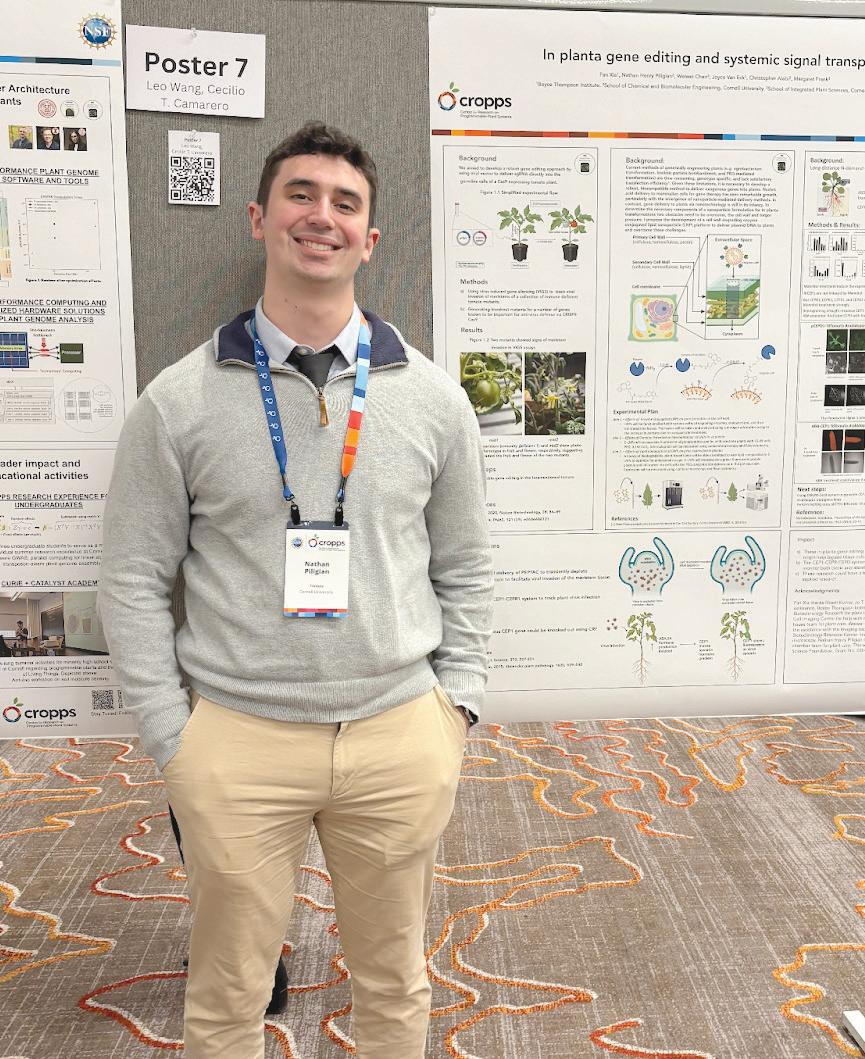
climate change and a whole bunch of other societal issues. Plants are central to everything that happens on this Earth,” Alabi said. “Being able to communicate with plants and engineer plants to be able to increase crop production, or to be able to resist the action of viruses or bugs, or to be able to
do just quite a vast number of things, I think is going to be important in feeding our entire population in the future.” Andrea Kim can be reached at
By Vivien Dobrescu
Vivien Dobrescu is a first-year in the College of Architecture, Art and Planning. She can be reached at vmd33@cornell.edu.
Spring semester has just begun, and while that might mean the end of the blissful winter break, it also means our cherished Big Red Bucks have reloaded!
The days of being embarrassed by how few BRBs you have left compared to your friends are over for now, and it’s time to cash in. Here are some of the best places on campus to spend your BRBs now that you actually have some to spend!
Goldie’s Cafe | Physical Sciences Building
According to multiple testimonials, Goldie’s has topnotch soups and sandwiches that you won’t find elsewhere on campus. Johanna Troelstra ’28 is a fan of the mini meatball soup, Albondigas. “I’ve also recently been thinking of trying the half sandwich and a cup of soup for $10,” Troelstra said, “but I’ve yet to pull the trigger.” Unique dishes, fairly priced meals and a convenient location make Goldie’s well-regarded by students.
Must Try: Muffaletta Sandwich, Portabella Mushroom Melt Sandwich and Albondigas soup
Cornell Dairy Bar | Stocking Hall
A classic Cornell institution, The Dairy Bar offers many Cornell Dairy products including ice cream, milk, yogurt, cheese and even butter. Most loved by students are of course the array of ice cream flavors to choose from.
Must Try: Three Chimes ice cream with salted caramel sauce and Ezra’s Morning Cup
Bus Stop Bagels | Kennedy Hall
Why walk all the way to Collegetown if you can go to Bus Stop Bagels and use up your ample BRBs instead? With fresh bagels straight from Ithaca Bakery and a reliable Starbucks drink lineup, Bus Stop Bagels is a no-brainer. Sanika Saraf ’28 said, “Bus Stop Bagels is super cheap. I can get a bagel with cream cheese for like three to
four BRBs! My go-to order is the Long Island bagel with sundried tomato cream cheese.”
Although their menu is sparse compared to CTB, try customizing your bagel order instead!
Must Try: Customized bagels, Route 10 and Route 15
Bear Necessities | RPCC
Bear Necessities is probably the only place to get food anywhere remotely near North Campus past 10:30 p.m. Out of necessity, many students flock to Bear Necessities and surprisingly find themselves coming back, even during broad daylight.
Must Try: Chicken tenders with honey mustard, the Bear Sampler and the 5-star subs
Café Jennie | The Cornell Store
Featuring Peet’s coffee and an array of quick bites, Café Jennie’s convenient location on Central Campus ensures frequent visitors. Café Jennie has quite unique sandwiches, wraps and pastries (such as Cheesecake Factory baked goods) compared to other cafes on campus.
Must Try: Ham & brie sandwich and the beef brisket sandwich
Terrace & Mac’s | Statler
The Terrace Restaurant in Statler is well-loved by students on campus for its madeto-order meals representing a plethora of global cuisines. From customized gyros to pho and salads, Terrace has a little bit of everything.
On a similar note to Terrace, Mac’s Café seems to be Terrace’s more casual cafe counterpart. They serve your pretty standard deli sandwiches, pizzas and salads, but multiple sources say the smoothies at Mac’s are the best if you are willing to wait out the lines after class!
Must Try: Anything from the Burrito Station (Terrace); Any smoothie (Mac’s)
Trillium | Kennedy Hall

By Ianna Banfield
Ianna Banfield is a sophomore in the College of Agriculture and Life Sciences. She can be reached at ib345@cornell.edu.
Trillium’s more classic dining hall layout sets it apart on this list of mostly graband-go cafes. With solid made-to-order Mexican and Asian food stations, Trillium always has an influx of students at the beginning of the semester when BRBs reload.
Must Try: Ramen, quesadillas, burrito bowls and orange chicken
Mattin’s Café | Duffield Hall
Mattin’s Café is the go-to spot for engineers because of its convenient location.
Juhyoung Lee’s ’27 favorite place to spend BRBs is Mattin’s because “it’s closest to the Engineering Quad where I spend most of my time and is quite reliable.” Mattin’s has your typical college cafe fare (soups, sandwiches and coffee), but also features menu specials like boneless chicken wings, specialty wraps and delicious soups. Shoutout to the checkout team for always being so friendly and making sure customers are taking care of themselves!
Must Try: Boneless wings and soup
Martha’s Café | Martha Van Rensselaer Hall
Martha’s Café features an amazing build-your-own bowl station similar to that of Cava. Jacqui Sparrow ’27 is a fan of Martha’s because they have “a lot of unique Mediterranean and Middle Eastern flavors like pickled onions, lamb kofta and baked falafel.”
With fresh, Mediterranean influences, Martha’s bowls are worth the heftier price for unique flavors you won’t find at the dining halls.
Must Try: Any build-yourown greens or grains bowl
As we close out the first month of the spring semester, take the time to explore the plethora of dining options Cornell has to offer now that BRBs have reloaded. While Cornell’s food scene may not often be described as exciting or groundbreaking, there are lots of hidden gems in the various cafes and eateries on campus. However, be warned of this extravagant lifestyle. Don’t end up checking off #130 on the list of 161 Things Every Cornellian Should Do; run out of BRBs in March; live off campus events’ free food for the rest of the year.
Birthday celebrations have always been something that I have taken quite seriously. I had a common checklist for every birthday of mine: I must dress special, have some sort of a photo shoot to post to social media and invite my closest friends.
Most importantly, the party itself needed to be as ostentatious as possible.
Given that I reside in the busy and bustling city of New York, my search for a venue never posed a challenge. Simply walking down the streets of Brooklyn or Manhattan (my typical stomping grounds), there were an array of tantalizing options: karaoke bars, escape rooms, Dave &and Buster’s, restaurants and other eateries, skating rinks, and many, many more. In fact, to celebrate one of my recent birthdays, I hosted a party at a hot spot in Manhattan where my friends and I made our own ice cream from scratch and ate it afterwards.
However, my first year of college catapulted me into a culture shock. Going away to a college campus in a rural area has some upsides and downsides. Evidently, the lack of nearby places is one of the downsides especially when it comes to matters such as this. A main disadvantage of not having a birthday during the summer is that it will almost always take place during the academic year, forcing individuals to celebrate their birthdays on their college campus.
Initially, this dramatic change of scenery had me worried. Ithaca appeared to be an unfamiliar and cold place, with few hints of eclecticism. Destinations that used to be on every other block in the city, such as pharmacies, could now be around a thirty-minute trek away. Spoiled by living in one of the busiest cities in the world, I first wondered if I would be able to cope with the meager venue options that existed in Ithaca. It did not help that as a December baby, my birthday is during one of the most inopportune times of the fall semester: the last week of class and finals period. When final deadlines and exams roll around, people are not necessarily in the most festive mood. Whilst I anticipated my birthday, the usual eagerness and excitement that bubbled within me were replaced with dread and uncertainty. Would my four birthday celebrations here be memorable or are they destined to be pity parties?
Luckily, after two shockingly successful birthday parties here at Cornell, I learned that it is very possible to have a memorable birthday celebration here. For those who are terrified of having a pity party this year, here are some ideas to make it feel less like such:
Believe it or not, there are many hidden gems in Ithaca that could be ideal for a birthday gathering. By bus, uber or perhaps by foot if you’re feeling athletic enough, a world of restaurants is accessible to Cornell students. For one of my friend’s birthdays, we took the bus to MIX Kitchen & Bar and had a small gathering there. “We had the most incredible food. We ate ice cream, cheesecake and calamari,”
shared said friend. Then, we asked the waiters for a candle, put it on one of the desserts and sang Happy Birthday to her.
For another friend’s birthday, we gathered at Kung Fu Tea in Collegetown and drank boba around a table. “We had tea and spilled some tea as well,” Chloe Padelara ’27 joked. “It was very fun and wholesome.” Another fun one is Texas Roadhouse. This country-themed restaurant is also in the town of Ithaca and has a very fun and creative way of announcing birthday wishes to its customers.
Go to an Event With Friends
There are many events that are on campus, such as the Carnelian Gala and the Black Women’s Support Network’s annual gala. If you’re lucky enough to have a birthday that falls on one of these events, then perhaps you could round up a few friends and go to the event together for a super fun birthday celebration.
An Old But Gold Idea: Party in a Dorm Lounge
Both of my birthday parties have been held in the lounge of my residential hall. Admittedly, I was not too excited about it due to my adjustment to opulent venues, but it ended up being memorable. Though this might seem like the most standard or bleak option, there are many things that you can do in the lounge that can make it feel special. This year, my friends and I used one of the TVs to play karaoke and other fun games that were available on YouTube. We played music, had ice cream and beverages and more. Fun themes could be implemented within the party. My lounge parties were often “pink” themed, so all of my friends dressed up in pink and brought pink-colored candies to the lounge.
Host a Sleepover
Perhaps, you could have a sleepover in your dorm with some friends. At the sleepover, you could do fun things such as a spa or movie night. Then, sing Happy Birthday and have cake inside your room. Perhaps, you could even have your friends from other colleges come to visit and sleepover as well. This is a fun way to ensure that the fun never lasts, carrying well over to the very end of your birthday evening.
Besides venues, there are other fun things that one can consider to make their birthday a smashing success. With the correct attitude, one can most definitely have a memorable birthday celebration on a college campus. Dressing up nice and having certain birthday rituals can make things more fun. Adding a theme to your party, such as making everyone dress up to a certain theme that you like or providing/ getting food that is tailored to the theme is a way to jazz things up a bit as well. Additionally, fun games and things to do can also add a sparkle to a party. All in all, even if your only option is a lounge or a bedroom, your party will only be a pity party if you do not keep an open mind. Though this may be cliche, it is not superficial things like the size or the venue that make a birthday party special: it’s the people and friends who make even the emptiest spaces feel full.

By ROWAN WALLIN
Sun Staff Writer
Feb. 1 — The Spring Festival Gala hosted by the Cornell Chinese Students and Scholars Association on Friday evening offered Asian students and community members a place to celebrate the Lunar New Year together and usher in the Year of the Snake.
The sold-out Bailey Hall event had hundreds of attendees, including current students and members of Ithaca’s broader Asian community — from grandparents to children. The event allowed students who usually celebrate the Lunar New Year with their families to find a community away from home and observe the holiday in a heartfelt way.
“It’s not like celebrating with your family actually, but ... you feel [like you belong].”
Winnie Zhou ’25
The gala was targeted specifically at Chinese students, with the majority of the narration being in
Mandarin Chinese. However, the emcees often offered an English translation introducing each act.
The gala’s message of celebrating as a community especially resonated with many international students.
“Being at Cornell, I can’t really be with my family — they’re in China — but I still have my friends to be my second family here,” said graduate student Wei “Tom” Liu.
Winnie Zhou ’25, who is from Shanghai, China, agreed that the Cornell community helped her feel less alone.
“All of the international students like me feel at home. It’s not like celebrating with your family actually, but … you feel [like you belong],” Zhou said.
This struggle was spotlighted by the short film opening the event, depicting Chinese Cornell students struggling with the homesickness Lunar New Year can bring while at college. The video concluded with them happily celebrating together by folding dumplings and attending the gala.
The Spring Festival Gala has become an annual fixture for the Chinese community at Cornell. Thinking back to her first gala when she was a first-year student,
Zhou said, “It’s getting better and bigger each year, so I would rank this year as the best year [yet].”
During the halfway intermission, the emcees awarded the lottery winners from tickets offered during admission. Audience members won prizes such as Cornell water bottles, AirPods Pros and a Dyson vacuum.
“You don’t really need to understand the language to appreciate the art.”
Amelia Abraham ’26
Graduate student Emilie Fu, who was born in 2001, shared her excitement about celebrating her Chinese zodiac year.
“I was born in the Year of the Snake,” Fu said. “I’m definitely more excited for this coming year because this is ‘my year.’”
When asked what she hopes for in “her year,” Fu replied, “getting a job offer.”
Eleven performances highlighted the great variety of Chinese cultural arts, including traditional
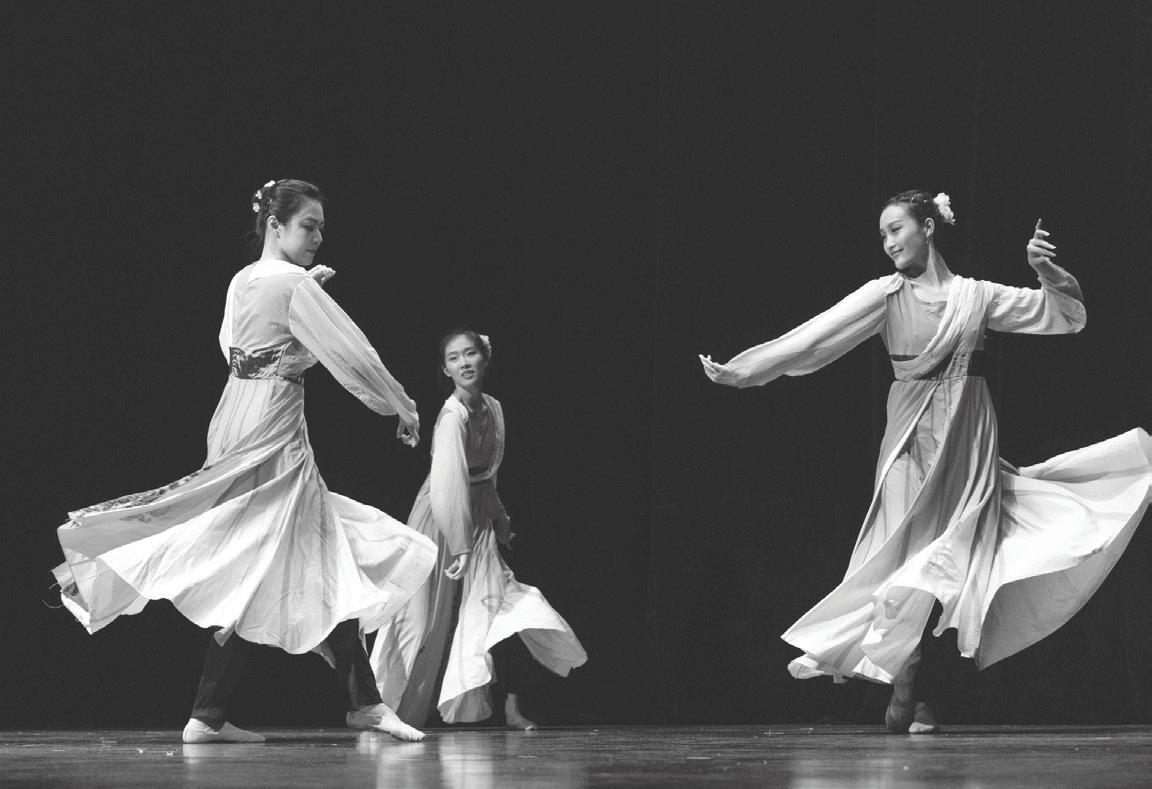


Chinese dancing, singing popular Chinese songs, martial arts and Chinese yoyoing.
The gala also featured a comedy-drama skit about fraud targeting an elderly man at a bank.
Opening the new year with humor, Chinese skits such as these are traditional for the annual Spring Festival Gala broadcasted on the China Media Group — which is an important event within the Lunar New Year celebrations.
The skit earned many laughs from the audience. While the skit was completely in Chinese, the language gap did not stop its message from reaching each and every attendee — such as Amelia Abraham ’26, who, despite not speaking Chinese, still found the skit entertaining.
“You don’t really need to understand the language to appreciate the art,” she said.
For the grand finale, gradu-
ate student Hanxi Xiao and Sofia Liu ’28 sang “Reflection” from Disney’s Mulan. They were accompanied by a choir of young children from the local Chinese school who illuminated the dark stage with handheld lights, bringing the Cornell and Ithaca communities together in one performance. It quickly became a crowd favorite, with Abraham describing it as “touching.”
Despite its primarily Chinese audience, CSSA’s gala succeeded in connecting Cornellians of all walks of life with Asian culture and language. Abraham said she found the prominence of spoken Mandarin throughout the gala “admirable.”
“It’s nice to see how much everyone cares about their culture,” Abraham said.
Rowan Wallin can be reached at rwallin@cornellsun.com.
By DALTON MULLINS Sun Staff Writer
Jan. 29 — Three men were arrested in Ithaca during an executed search warrant in a drug trafficking investigation on Wednesday.
During the execution of the warrant, police found narcotics, drug paraphernalia and an illegally possessed dagger on the scene according to an Ithaca Police Department media release.
The search warrant was executed at approximately 4:30 a.m. at 118 East Green St. by the Ithaca Tompkins Specialized Response Team — a group of IPD Officers and Tompkins County Sheriff Deputies.
In response to police findings, 23-year-old Anthony
Teutonico Jr. and 20-year-old Kevin Krise were both taken into custody and transported to the Ithaca Police Department.
41-year-old Benjamin Sturdivant was apprehended during the search warrant for having active bench warrants for criminal possession of a controlled substance in the seventh degree and harassment in the second degree. A court issues a bench warrant when an individual fails to comply with court procedure such as when an individual fails to appear in court.
Teutonico Jr. was charged with criminal possession of a controlled substance in the third degree, a Class B felony, and for criminally using drug paraphernalia in the second degree, a Class A misdemeanor. After arraignment in Ithaca City Court, Teutonico Jr. was
remanded to the Tompkins County Jail.
Krise was charged with criminal possession of a weapon in the fourth degree, a Class A misdemeanor; criminal possession of a controlled substance in the third degree, a Class B felony and criminally using drug paraphernalia in the second degree, a Class A misdemeanor.
Sturdivant was placed in custody and brought to Ithaca City Court. Following being arraigned in Ithaca City Court, Krise was released on his own recognizance — which is when an individual is released without bond by agreeing to appear on their court date.



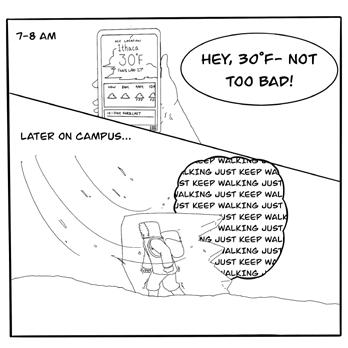
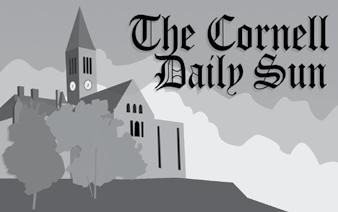


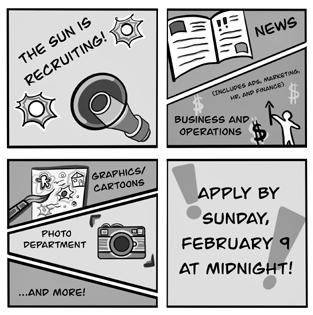


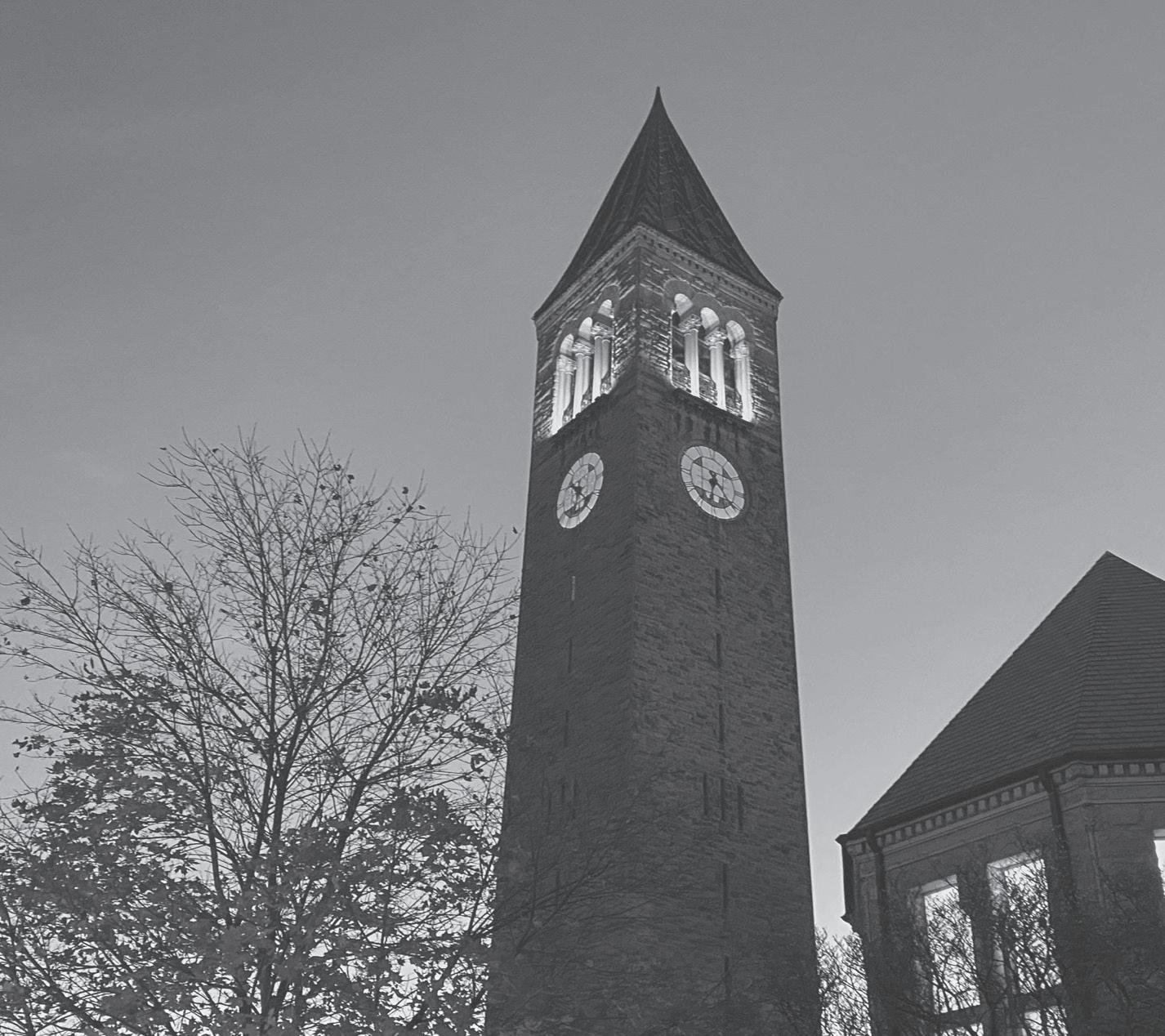
By VARSHA BHARGAVA
Jan. 29 — Behind tiers of scaffolding, McGraw Tower’s clock normally shines white, but every so often, circles of orange, green or red glow from its faces.
Up its 161 steps, the clocktower houses the Cornell Chimes. The Chimesmasters, a small group of students who play daily concerts, light the different faces of the clocktower for five occasions throughout the year — Homecoming, Halloween, Veterans Day, Valentine’s Day and Dragon Day.
Head Chimesmaster Aidan McNay ’24, now pursuing a master of engineering, described the tower’s holiday colors as “small sparks of wonder” on campus.
“We hope to provide a little bit more excitement and spirit to the student body as a whole,” McNay said. “It’s easy to lose track of special occasions with the many tasks that Cornell students have to juggle, so the colors can help serve as a reminder to take a break and connect with the friends and Cornell family around you.”
Lighting the clock faces also inspires joy inside the tower. The Chimesmasters work together to decorate the inside of the tower for holidays and often light the clock faces as a group. While the role of lighting the clock faces normally falls upon the head chimesmaster, McNay said that it is fun to include everyone in the room.
“We hope to provide a little bit more excitment and spirit to the student body as a whole.”
Aidan
McNay ’24
Pumpkins in the Sky
On Halloween, the clock faces wear costumes of their own. The Chimesmasters use LED lights to transform the faces into orange jack-o’-lanterns that loom over the campus.
The tradition of turning McGraw Tower’s clock face into a pumpkin began in 1964, according to current Chimes Advisor and former chimesmaster Jennifer Lory-Moran ’96 M.A.T. ’97.
Former chimesmaster Bob Feldman ’66 Ph.D. ’75 began the spooky practice with theatrical gelatin and cardboard. After using the gelatin to turn the clock faces’ incandescent bulbs orange, Lory-Moran said Feldman added large cardboard eyes and mouths for the “full jack-o’-lantern effect.”
Feldman’s innovation led to the creation of new traditions for other holidays. After lighting the faces for Halloween, Lory-Moran said the Chimesmasters started lighting the clock faces green for Dragon Day.
In 2015, the Chimesmasters installed LED lights that allow them to light the clock faces any color and expand to other holidays.
‘Small, but Important’ Symbol for Veterans In 2016, the Chimesmasters changed the clock face colors on Veterans Day for the first time.
Cornell changed McGraw Tower’s lighting policy to include Veterans Day after David Outlaw-Batista ’17, co-founder and former president of the Cornell Undergraduate Veterans Association and a U.S. Navy veteran, requested that they honor the country’s veterans.
“At the very least, [the colors are] an excuse to text those friends you haven’t talked to in a while and say, ‘Hey, look at the tower it’s green!’”
Aidan McNay ’24
Originally, Cornell Chimes denied the request, according to Outlaw-Batista’s 2016 Letter to the Editor, but CUVA and other students worked with administrators to change the policy. Outlaw-Batista said he “respects the process [they] went through and [he is] happy with the result.”
Outlaw-Batista and CUVA made this request as a part of the “Greenlight A Vet” initiative. The initiative encourages community members to display green lights around their homes to show veterans that they are welcomed and acknowledged, Outlaw-Batista said.
“That inner saboteur after you get out of the military tells you [that] you don’t belong in a prestigious university,” Outlaw-Batista said. “Hopefully [the lights] give [veterans on campus] a little bit of hope that they are valued within the Cornell community.”
Now, every year on Veterans Day, the clock shines green from the landmark on campus.
“I still check every year to make sure they’re doing it,” Outlaw-Batista said. “I hope that it continues because it’s a small, but important symbol to let veterans know that they do matter.”
For the Chimesmasters, filling passersby’s “ordinary evenings” with color and maintaining tradition for many generations of Cornellians is powerful, McNay said.
American Studies lecturer and de facto Cornell historian Corey Ryan Earle ’07 described the changing of the clock’s face to be an important campus tradition.
“[The clock face colors tradition] is a small thing that brings some joy and playfulness to the Cornell community, … [and traditions like this] can help humanize the institution,” Earle said.
Since 1964, the decades-old lighting tradition has “brightened the day” of generations of Cornell students, McNay said. He hopes that by continuing, the clock faces foster more connections on campus.
“Real life moves fast, and it’s easy to lose track of the people around you,” McNay said. “At the very least, [the colors are] an excuse to text those friends you haven’t talked to in a while and say, ‘Hey, look at the tower — it’s green!’”


By ZEINAB FARAJ Sun Staff Writer
Feb. 4 — Ivy League Executive Director Robin Harris emailed student-athletes and coaches of the league’s decision to opt out of the House v. NCAA settlement on Jan. 21. This announcement sparked a range of reactions in Cornell’s athletic world — from remorse to relief.
Historically, athletes in the National Collegiate Athletics Association had been prevented from earning money off their name, image and likeness, until 2021 when the NCAA decided to overturn the policy. Now, the proposed settlement will require the NCAA to pay $2.78 billion in back pay to athletes who played between 2016 and 2021 to compensate for missed profit off of their NIL.
However, since the Ivy League opted out of the settlement, former Cornell athletes would not qualify for any back pay on NIL profits that the settlement would provide if passed. According to Harris’ email, Ivy League schools will continue to refrain from providing student-athletes with revenue-sharing allocations, athletic scholarships or direct NIL payments. Ivy League teams will not have to follow roster limitations set by the NCAA.
“I can understand [the Ivy League’s] perspective on opting out but I still think that athletes deserve some sort of support, whether it be financial or just help in the NIL world.”
Doryn Smith ’26
The Sun spoke to three Cornell athletes — senior football quarterback Jameson Wang, junior football wide receiver Doryn Smith and former Cornell volleyball player Sydney Moore ’24 — along with sprint football head coach and sports lawyer Prof. Michael L. Huyghue ’83, law, to better understand the decision.
Wang described his initial reaction to the Ivy League’s decision as “disappointing” to all the student-athletes who “worked hard to get into and excel at an Ivy League.”
While Wang does not think the Ivy League will become less competitive, he acknowledged the impact of the settlement.
“If schools were able to leverage money
to attract high-level recruits, the competition among the [Ivy] League schools would only increase.”
In the Jan. 21 email, Harris stated that the Ivy League’s Division I status and participation in NCAA championships will not be impacted by the opt-out move.
Wang also detailed other ways the Ivy League is moving in the right “competitive direction,” such as the Dec. 18 decision to allow the Ivy League to participate in the NCAA Division I Football Championship Subdivision Playoffs starting in the 2025 season.
Wang is active in the NIL space. He had partnerships with Degree Deodorant as a part of their Breaking Limits Team campaign and Wilson Football, among other companies.
Smith also expressed that the decision was “unfortunate and disappointing” to him as he enters his final season with the Red.
“Even though the academics here are world-class, being an athlete here is a time-consuming commitment,” Smith said. “I can understand [the Ivy League’s] perspective on opting out, but I still think that athletes deserve some sort of support, whether it be financial or just help in the NIL world.”
Smith has had a variety of NIL profits as a wide receiver for the Red. He was a Brooks Running ambassador and currently works with Gainful.
On Moore’s podcast, Let’s Talk About It, she interviewed attorney Stephanie Verdoia, who worked on House vs. NCAA, about the implications of the case.
Moore who finished her last season of eligibility in the Atlantic Coast Conference at Syracuse University — a team that will not be opting out of the NCAA settlement. She said she was “not surprised” by the settlement. Moore said she understood that, if she had filed a claim as a former Cornell athlete to receive reimbursement, she “would not have received the same value as athletes who participated in Division I sports outside the Ivy League.”
“I think the Ivy League should definitely consider giving athletic scholarships,” Moore said. “We are a competitive athletic conference but, considering the facts of the case and what an Ivy League athlete is signing up for, I do not think we necessarily fit the case.”
Huyghue asserted that not opting in allows the Ivy League to maintain its “core traditions and standards.”
“The reality is that college is not a four-year decision. It’s a 40-year decision,”

Huyghue said. “Athletes that go to Ivy League schools are going to benefit far more than the amount of money that some [athletes] will receive to go to schools that do not have the same level of academics.”
An Ivy League degree has been valued by students and employers for its prestige and access to research and resources. Huyghue, who lettered in football and baseball for the Red, accredited his success to his Cornell education.
“The reality is that college is not a four-year decision. It’s a 40-year decision.”
Prof. Michael L. Huyghue ’83, law
“Sports was definitely the most important thing to me and yet I became a lawyer, commissioner and a general manager,” Huyghue said. “It’s why I’m here every day trying to do everything I can to give the same experience to other students.”
Opting Out and Moving On: The Future of Athletics
Effective immediately, all Division I athletes will be required to report any third-party NIL deals of $600 or more to their member institution in which they are enrolled and/or a designated reporting entity, aiming to prevent abuse or exploitation of these deals, according to the NCAA.
The main questions on everyone’s minds now: what will the future of athletics look like? Will recruiting processes be impacted?
From a coach’s perspective, Huyghue stated he believed that recruiting would not be impacted as there will always be a “value of a Cornell degree” that athletes will remain attracted to.
Huyghue considered the ethical responsibility of giving young athletes the ability to profit off their abilities without giving them the tools to manage their wealth or a backup plan for potential injuries would cause more harm in the long run.
“We have an educational responsibility and fiduciary responsibility that doesn’t exist in the pros that these schools should seriously evaluate,” Huyghue said.
The idea of walking on to an Ivy League sport is protected by opting out because the decision does not subject teams to roster limitations.
“What will hurt programs that opt into the [settlement] is it will almost eliminate walk-ons,” Huyghue said. “It’s amazing
how walking [on] can still end up being a significant part of your team. … Undrafted players in the National Football League — about 15 percent of them are starters.”
Not having roster caps also prevents athletes on teams from being cut. Moore, who played volleyball for Syracuse this past year, has seen the downsides to these roster cuts firsthand.
“The grass is not greener in the Power Five. I have friends on the [Syracuse] women’s field hockey and soccer that are being cut,” Moore said. “[Athletes] are not protected and are having a hard time transferring to pursue their sports elsewhere.”
Further, opting out may be seen as a way for the Ivy League to support Title IX, a federal law that prohibits sexual discrimination in any educational program or activity that receives federal funding.
Schools that opt in to the settlement are eligible to receive funds from the NCAA to spend on their athletic programs. They are expected to be able to divide this money between their various teams at their own discretion. This draws concerns that larger, more popular sports could receive more funding whereas smaller sports are at risk of losing funds.
“Are the schools opting in even going to worry about Title IX? How will they determine which sports get ‘x’ amount of dollars?” Moore said. “It’s not just gender equity but also [the] popularity of a sport that could be jeopardized.”
So, are there other ways for the Ivies to support their student athletes’ needs? Wang says he hopes to see the Ivy League assist athletes in paying for tuition.
“By opting out, you are not [helping] student-athletes pay for tuition, so [you are] placing the burden of tuition on students and their parents,” Wang said. “Making them find other ways to pay just does not seem fair to me.”
Wang added that he has had to find other ways to pay for school, including starting his own shoe reselling company, 8erakicks.
Smith said he wants to see the Ivy League support its athletes in NIL deals.
“More assistance navigating life as a college student, paying tuition, find[ing] a balance with school and your sport,” Smith said. “We definitely deserve some kind of compensation for our competitiveness so I think it is a question of what [the Ivy League] is willing to do for us, [and] how much do they value their athletes.”
Zeinab Faraj can be reached at zfaraj@cornellsun.com.

AIMA RAZA ARTS & CULTURE CONTRIBUTOR
Imagine the picturesque Lebanese mountain village of Dhour El Choueir in the late 1940s: its streets, alternately chalked and cobbled, meandering beneath the sunlit embrace of burnt sienna facades that crown the brick-and-mortar shops encircling its bustling roundabout. In Out of Place , Palestinian-American literary critic Edward Said remarkably traces an exalted recollection of his life between cultures — Cambridge’s academic halls and Cairo’s teeming streets, Jerusalem’s contested sanctity and Beirut’s cosmopolitan allure — tangled and torn apart by the dispossessing and seismic reverberations of the Arab-Israeli War, Egyptian Revolution and, later, the Lebanese Civil War.
Throughout the memoir, we witness the Middle East gradually receding from Said’s consciousness — an identity increasingly relinquished through the trajectory of his education. From Gezira Preparatory School to the Cairo School for American Children, from Victoria College to Princeton University, then Harvard College, and ultimately culminat -
There’s an old expression that warns against mixing your all favorite ingredients together, because the end result won’t always be delicious. It’s possible I actually made that up; regardless, it’s an important saying to keep in mind as I weigh in on the recent explosion of “romantasy” in popular literature. In theory, these novels are a conglomerate of all the things I love —- adventure, handsome men, dragons, etc. —- yet I abhor them. (Another thing I love, using words like “abhor.”) I absolutely ABHOR romantasy novels!
Please bear with me as I attempt to explain my potentially unpopular opinion, starting with some necessary definitions. The novel subgenre of romantic fantasy is broadly defined as books that feature romance in the context of a fantasy world. This describes about half the books I’ve ever read, so I’ll clarify that when I refer to “romantasy” in this article, I am imagining a romance plot that would be largely unchanged if you removed it from its fantasy backdrop. While these types of books are not a new phenomenon, Sarah J. Maas’s A Court of Thorns And Roses series skyrocketed the genre into popularity in 2015. Since then, these books have been festering and
ing in his appointment at Columbia University, each step seems to disparately widen the chasm between Said and the region that so intensely shaped his earliest memories. The once-vivid image of Dhour El Choueir’s hot, cloudless summer skies has faded into near nonexistence, replaced by a vision of a ruined town marred by bullet scars and strewn with rubble. As Said reflects on this afflicting and disorienting reality, while battling leukemia, his recounting is marked by the poignant weight of loss and transformation.
The current, desolate state of Palestine is no stranger to this crumbling disposition and pain of degeneration — a mere twenty-one years after Said’s passing. For many diasporic individuals, confronting the lingering ache of disconnection often requires seeking solace in the smallest, most intimate corners of art and memory. Like Said, who found refuge in the balcony seats of the Rivoli Cinema, the teetering keys of a spinet piano and the soaring ballads of Umberto Giordano, these moments of artistic engagement resonate with a peculiar intensity for those uprooted. They become sanctuaries where the fractured pieces of identity can momentarily coalesce, offering both
an escape from dislocation and a means of processing it.
For Said, this duality manifested not only in the grand geopolitics of his time but in the deeply personal dissonance of existing between worlds. His identity — torn between the demands of Western academia and the cultural imperatives of his Middle Eastern roots — was not simply a matter of intellectual exploration; it was an emotional and existential struggle. As he ventured further into the corridors of Western institutions, from CSAC to Columbia, his sense of self became ever more fragmented, as if the very act of education required him to shed the person he had once been. In this process of self-erasure, there was a constant undercurrent of insecurity and the gnawing feeling that he was never quite enough to fit either world.
This tension lies at the heart of the diasporic experience: to be neither fully of one place nor the other and to grapple with the underlying insecurity that accompanies such a split identity. The journey through this liminal space is marked by moments of doubt, a yearning for a home that feels ever more distant and the painful recognition that, despite all efforts to reconcile these fragments, some parts of the self may remain forever unful -
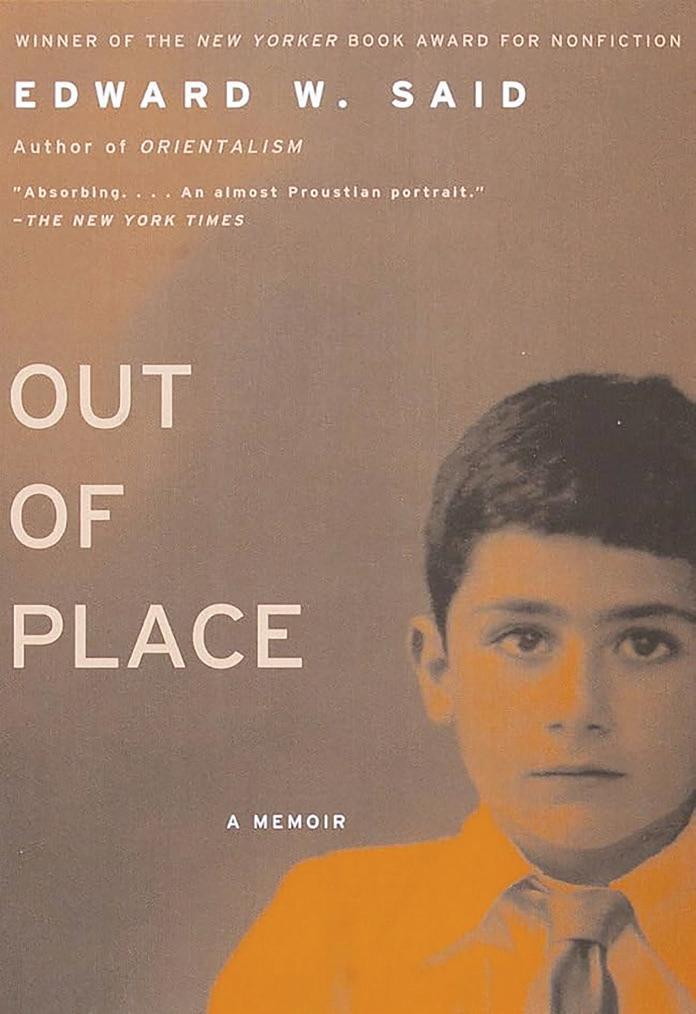
filled. Yet, it is through these very fractures that the diasporic individual often finds the strength to redefine identity — not as a fixed point, but as a constant negotiation between past and present, home and exile.
Aima Raza is sophomore in the School of Industrial and Labor Relations. She can be reached at ar2548@cornellsun.edu.
multiplying in a cursed corner of the Internet. If you’re chronically online in all the wrong ways, you know I am referring to “Spicy Booktok.” I shudder to even type out the phrase. The dark abyss where romantasy and Spicy Booktok practice their twisted mating ritual is what I would show the Devil if he needed assistance crafting my personal hell.
I’ll be honest and say that I haven’t read very many of these novels I hate so much, mostly because they make me want to gauge my eyes out. But I wouldn’t be qualified to hate on the genre if I hadn’t at least given it a try. My first encounter with romantasy was through an attempt to rekindle an old spark with books. As a young reader, I devoured fantasy novels: Harry Potter, Narnia, Septimus Heap, Lord Of The Rings, Chrestomanci… I could keep listing them forever. In the whirlwind of college life, I’ve sadly fallen off my reading habit, but I often crave that feeling of getting lost in a good book. So I turned to the Internet to see what the critics were recommending, and that’s how I found myself reading Fourth Wing by Rebecca Yarros. Reader, I couldn’t get past Chapter 8. Is it possible to convey how incessantly this book
made me weep for the future of literature? The fantasy setting is forgettable at best and overtly mimics the worlds of iconic YA series. Divergent-style quadrants split up the nation’s youth at Dragon Hogwarts — I mean, Basigath War College. They are training for the Hunger Games (or something) but our main girl Violet can’t focus on her
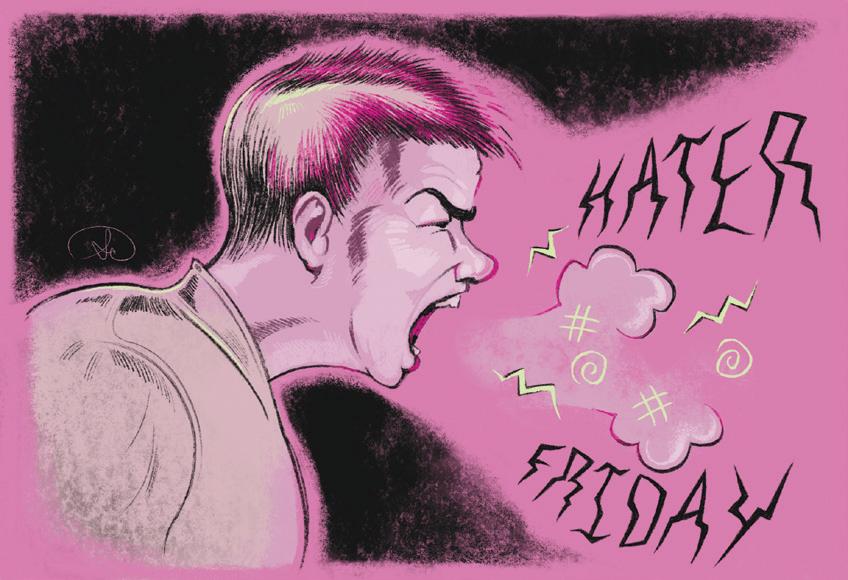
dragon studies because the guy she hates is just soooo dreamy. Even if I could look past her hand-wavy world-building and alphabet-soup character names (Xaden Riorson?? Sounds like an anxiety medication), Yarros boasts overused clichés such as “his eyes darkened” or “my heart dropped” in every sentence. It’s obvious that details and imagery are second to the main plotline: the love triangle between WhatsHer-Name, the Nice Guy and the Buff Jerk. Repressed millennial women everywhere were swooning at Mr. Riorson’s darkened eyes, I’m sure.
You might be thinking,
“Maya, all of those old novels you love so much feature a dashing young wizard/prince/hobbit/elf, you can’t tell me that’s a coincidence.” Of course it’s not. I’m a huge romantic, and all of my first loves were men of ink and parchment. But am I wrong to think that at the ripe age of 22, it’s more appropriate to obsess over a real flesh-andblood man? If you are my age and older and still have “book boyfriends,” I have some serious follow-up questions.
That being said, my real issue is not that books like Fourth Wing exist and are enjoyed. Lord knows I indulge in my fair share of trashy television, and I won’t disparage anyone’s brainrot of choice. What really grinds my gears is the multitude of raving reviews these novels inspire. Spicy Booktok romantasy readers seem to think they have discovered the new Golden Age of literature (and you can hear how wrong that sentence sounds). I’ve seen fans of these books refer to themselves as “bookworms” and “obsessed with reading,” which, I’m sorry, makes me want to punch a wall. If you think fairy smut surpasses Jane Austen as romantic literature, you do not fall under the bookworm category. This is coming from a girl who won the most Accelerated Reader awards
in her second grade class; I ain’t playing around.
To add an amendment to my opening proverb: it doesn’t matter how good your ingredients are if you don’t know how to cook! Putting content aside, these books are certifiably bad literature. Fourth Wing reads like a mediocre YA novel, which is problematic because you do NOT want this book in the hands of your middle schooler. How can an author sleep at night after infusing such an intermediate-level piece of writing with the most absurd, explicit sex scenes? I haven’t really addressed the “spicy” factor of these books, because I think it requires a different type of article. I’ll say, though, that Fourth Wing is pretty mild compared to some other romantasy novels people praise for their “spice levels.” Look, I’m not naive. I know why people like to read ahem mature content; by no means am I hating on anyone for their enjoyment of that. But if you look me in the eye and tell me that your idea of the Great American Novel features dragon-on-dragon or girl-ondragon or guy-on-girl-riding a dragon… I’ve only got one thing to say to you. GET OUT OF THE DAMN KITCHEN!
Maya Blanchard is a junior in the College of Agriculture and Life Sciences. She can be reached at mhb237@cornell.
On Sunday, March 2, the 97th Academy Awards will honor the most notable films of 2024. Among the numerous movies nominated and competing for the chance to grab one of the golden trophies, ten individual films have been decreed the greatest of 2024. The following were nominated in the category of Best Picture: Anora, The Brutalist, A Complete Unknown, Conclave, Dune: Part Two, Emilia Pérez, I’m Still Here, Nickel Boys, The Substance and Wicked . From a biopic about Bob Dylan to a musical taking audiences back to Oz, the nominations represent the astounding breadth of cinema this year. Most notably, the lineup features one science-fiction movie ( Dune: Part Two ), one horror movie ( The Substance ) and one fantasy movie ( Wicked ). Upon scrolling through the Oscars nomination database all the way back to the first one in 1927, a trend appears — it seems that almost all nominations for the Best Picture category have been from the genre of drama.
The Best Picture award at the Oscars recognizes the “best motion picture of the year.” Originally titled “Outstanding Picture,” the first winner was Wings (a female detective drama), and recent popular awardees include Oppenheimer, Everything Everywhere All at Once and Parasite. Traditionally, winners and nominees for Best Picture have been drawn-out, serious, fictional films centering on the development of characters in the real world. Only recently have films from more fantastical backgrounds broken into the elite circle of Best Picture nominees. In fact, according to ScreenRant, only seven horror movies have even been considered for Best Picture. One of the films on that list is this year’s nominee, The Substance. The Substance is a body-horror movie starring Demi Moore. Her character, Elisabeth Sparkle, is an aging celebrity who succumbs to a black-market drug to create a younger double of herself. Though only receiving a 75 percent audience score on Rotten Tomatoes, The Substance has largely been heralded as a smashing hit. However, it will be
going up against such powerhouses as Emilia Pérez and The Brutalist, which combine for a total of twenty-three nominations. Not only that, but as a horror film, The Substance has a distinct disadvantage. Only one horror movie has ever taken home the golden trophy for Best Picture: The Silence of the Lambs . Furthermore, even films such as Jaws , which won three other Oscars, could not secure the elusive Best Picture trophy. Facing such impossible odds, it is necessary to question the validity of an Academy that does not recognize all talent in the vast industry of film.
What is the Academy? The Academy of Motion Picture Arts and Sciences is an organization of experienced actors, actresses, directors and film workers who decide on Oscar winners. Composed of nine branches, the Academy brings together experts of the cinema world in order to create a fair voting environment. But how fair is it? According to the Academy Membership page of the Oscars website, the “membership process is by sponsorship, not application.” In order to gain entry into the hallowed voting ranks, prospectives have to be sponsored by two current members of the Academy. Even if a director or actor was the best in the field, if they could not accrue the favor of two Academy members, they would not be allowed in. Therefore, this approach breeds bias and favoritism. Even more interesting is the fact that the Academy does not publish the demographics of its own five-thousand-plus organization, making information on diversity within the group difficult to come by. Los Angeles Times reporters in 2012 undertook the painstaking project of acquiring demographic information on the Academy and found that voters were 94 percent white and 77 percent male. A lack of diversity within the Academy could be the key to understanding the lack of diversity in film nominees and winners. Without new ideas and differing perspectives, the Academy will only continue to struggle with recognizing incredible movies outside the drama genre.
More fantastical movies are radically different from their more realistic counterparts. Besides the obvious dissimilarities of content matter, fantasy,
sci-fi and horror films often rely more upon special effects, epic visuals and intense fight scenes to draw crowds. Drama movies, on the other hand, often allow more time for actors and actresses to showcase emotional range and overall skill. Among critics, this can lead to a general condescension towards such works. For example, the Academy wouldn’t necessarily be searching the scores of superhero movies to discover a gem. In fact, only two superhero movies have been recognized at the Oscars and neither for Best Picture. Heath Ledger won Best Supporting Actor for his role in The Dark Knight, and Joaquin Phoenix won Best Leading Actor for his role in Joker . Interestingly, both these awards were for the character of Joker, a role that lends itself to more psychological acting. Besides the lack of superhero movie representation in the Best Picture category (with many potentially deserving it, like The Dark Knight ), fantasy movies do not often fare well, either. The best example here is the Lord of the Rings trilogy The Fellowship of the Ring, The Two Towers and The Return of the King were all nominated for Best Picture. Only The Return of the King was able to snatch the trophy, however. The Fellowship of the Ring and The Two Towers , instead of winning Best Picture, won awards for Visual Effects and Cinematography, the two areas in which fantasy movies most often excel. However, when considering the merit of the movies as noteworthy and impressive pieces of art, only The Return of the King was able to succeed. Problems are hard to avoid when bringing together elite groups to rule upon the quality of art. Even though the Academy has had trouble appreciating genres other than drama, there seems to be hope. Looking only at the past few years, more fantasy and horror movies have been nominated and won major awards at the Oscars, from Everything Everywhere All at Once to Poor Things. This year is shaping out to be one of the best yet for unconventional genres.
Jane Locke is a freshman in the College of Arts & Sciences. They can be reached at jlocke@cornellsun.com.
By ELI FASTIFF Sun Staff Writer
Less than 24 hours after taking the lead in the ECAC thanks to a 6-0 statement win over No. 7 St. Lawrence, No. 5 women’s hockey extended its margin over second place Colgate to 1.5 points by knocking off No. 9 Clarkson, 2-1. With the six-point weekend, Cornell has clinched a top-four seed and the accompanying first round bye in the ECAC postseason tournament.
“It was a good game. Both these teams are top teams in the country so you have got to show up,” said junior defender Alyssa Regalado. “It’s pretty cool to come out on top.”
After an offensive explosion the night before, head coach Doug Derraugh’s ’91 prediction of a more defensive matchup was proven correct.
For Cornell, the first high-percentage chance of the game came just three minutes in, but senior forward Gabbie Rud couldn’t handle a deflected pass to capitalize on a two-on-one rush.
For the next 10 minutes, a battle of netminders ensued. Holly Gruber’s efforts to keep the Red off the scoreboard were mirrored by sophomore goaltender Annelies Bergmann, who made a series of lunging saves to keep the game tied 7:30 into the game.
After many impressive saves from each side, it seemed inevitable that a shot would finally find its way into the back of the net.
Unfortunately for Cornell, that moment came with 7:57 left in the period when Clarkson forward Sena Catterall deked a Cornell defender and slipped the puck beneath Bergmann’s pads. The goal was the Golden Knights’ first against Cornell since Jan. 5,
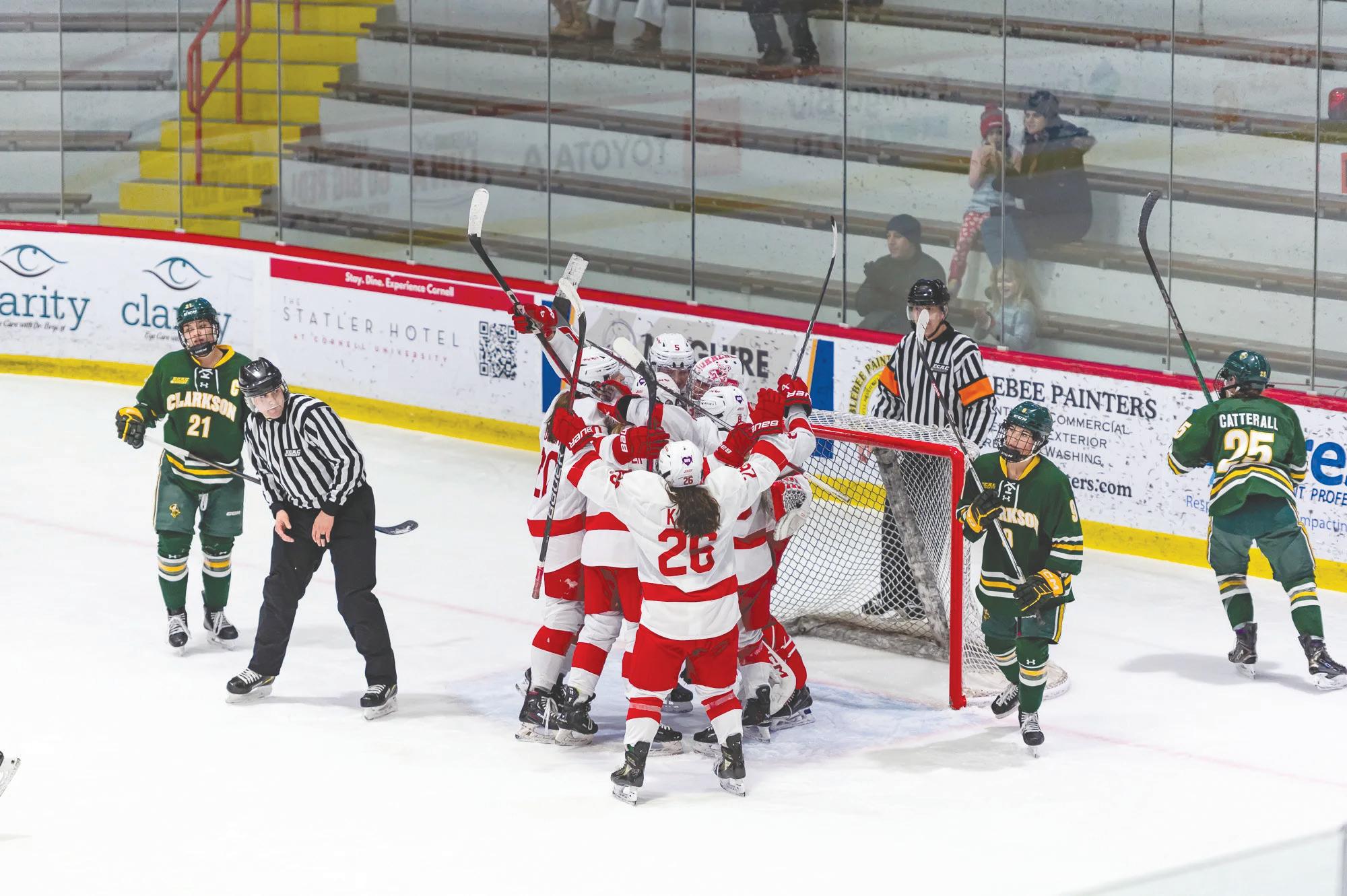
BURKE / SUN ASSISTANT PHOTOGRAPHY EDITOR
Celebrating the clinch | A 2-1 win against Clarkson secures a top-four seed and first round bye for Cornell.
2024.
Less than a minute after taking the lead, a Clarkson skater was whistled for hooking and the Red’s power play unit — entering the matchup ninth in the nation — took to the ice with a chance to quickly tie the game. Instead, Gruber continued to stymie Cornell’s offense and the Red could not convert on the skater advantage.
A Bergmann save on a shot from the low slot with 1:37 remaining in the period was met with a Gruber save on an open look from sophomore forward Karel Preforntaine seconds later, and Cornell entered the first intermission remaining down a goal.
During the first intermission, Derraugh reminded his team that despite the deficit Cornell’s offense still looked potent.
“Coach said to us ‘you have
got to score a goal to win,’” Rud said. “So we knew as long as we kept putting pucks to the net and playing the way we were playing, something good was going to happen.”
However, Clarkson controlled the opening minutes of the second period as the Cornell offense struggled to maintain possession of the puck in the offensive zone. It wasn’t until over halfway through the period that Cornell’s offense finally seemed to come to life.
The brief momentum swing ended when Regalado was penalized for tripping, giving Clarkson its first power play of the game. The Cornell penalty kill unit killed its fourteenth penalty in a row, and two minutes later Clarkson committed a penalty of its own.
Cornell’s second power play
looked stronger than the first, and the Red nearly tied the game when Prefontaine launched a one-timer that rang off the crossbar.
Then, after multiple quality scoring chances with the skater advantage, the Cornell pressure finally paid off. For the second night in a row, a senior defender Rory Guilday slapshot from the point got the scoring started for Cornell.
“[Our] special teams got a big goal for us,” said Derraugh. With the score tied, Clarkson began to push for a second goal to break the deadlock. With 1:30 to go in the second period, multiple shot attempts off rebounds lead to Bergmann sprawling out in her crease to prevent a Golden Knight goal.
Moments later, Guilday was whistled for tripping and Cornell was back on the penalty kill. The
action-packed period finally came to a close, but not before play had to be stopped due to goaltender interference by Clarkson’s power play unit.
Despite tying the game, Cornell looked like the lesser team for large swaths of the second period, with Bergmann being forced to make nine saves to Gruber’s four.
The third period was marked by a series of penalties. Cornell started the final frame by finishing killing the Guilday penalty, before earning an advantage a few minutes later. However, just 25 seconds into the Cornell power play senior forward Claudia Yu was called for interference, setting up 1:35 of four-on-four play.
While neither team could score during the four-on-four play, the Golden Knights nearly regained the lead. With 10:43 to go in the third period, Bergmann was caught out of position with a rebounding puck in front of the net. Luckily for Cornell, Regalado kept the score tied by stopping a Golden Knight shot attempt with her skate.
“I saw a girl coming off the back door, and I knew we were a little bit out of position. …I was like, ‘you know what? The puck has got to stay out of the net,’” Regalado said. “So I did whatever I could to make sure that the puck stayed out of the net.”
25 seconds after the Yu penalty was complete, Cornell was awarded another opportunity with a skater advantage. The Red forced multiple difficult saves from Gruber, but again failed to capitalize on the power play.
To continue reading this article, please visit www.cornellsun.com.
Eli Fastif can be reached at efastif@cornellsun.com
By JANE McNALLY Sun Sports Editor
Scoring has not come easy for men’s hockey over the 2024-2025 season.
Cornell averages 2.8 goals per game, an average that hasn’t dipped below 3.0 since the 2016-2017 season. Injuries have ravaged the Red’s forward group, putting pressure on the few healthy skaters to produce.
But facing the lowest-scoring team in the ECAC on Friday, Cornell had a chance to open the offensive floodgates, in desperate need for points to climb up the ECAC standings.
But offensive issues only worsened on Friday. Barely able to assemble a full roster, Cornell fell to last-place St. Lawrence, 2-1, continuing the downward spiral of a season that had tremendously high expectations.
Ahead of puck drop, the storylines wrote themselves — Cornell (8-7-5, 5-5-3 ECAC) was forced to dress eight forwards and nine defensemen, compared to the usual 12 and six, respectively. This is likely a result of further disciplinary action taken by the ECAC after the post-game brawl between Cornell and Dartmouth last weekend.
Senior forward Kyle Penney, senior
forward Jack O’Leary and sophomore defenseman Hoyt Stanley were handed disqualifications last Saturday, and thus were automatically suspended for Friday’s game. New absences from the lineup included senior forward Ondrej Psenicka and junior forward Nick DeSantis, the latter likely the result of further suspensions.
Whether or not those suspensions will last longer than one game remains to be seen, as the ECAC has a policy where all suspensions and disciplinary action are dealt with internally.
The Sun previously reported that head coach Mike Schafer ’86 was anticipating a suspension. Schafer was not present behind the bench on Friday, and sources have reported that the head coach did not make the trip to North Country due to a suspension, which would mean that he would also miss the Saturday game against Clarkson.
The Saints took advantage of Cornell’s depleted lineup quickly. Outshooting Cornell 10-5 in the opening period, St. Lawrence got the game’s first goal 9:14 into the contest when Will Arquiett beat senior goaltender Ian Shane.
St. Lawrence (8-16-1, 4-8-1 ECAC) didn’t muster a ton of high-danger
chances besides the goal, but Cornell’s highly defensive lineup failed to drum up much in the offensive zone. That would change quickly into the second period, when senior defenseman Hank Kempf cleaned up a rebound, knotting the score at 1-1 2:17 into the middle frame. The tally marks Kempf’s first goal of the season, just six days after sophomore defenseman George Fegaras notched his first of the year against Dartmouth.
Despite staying relatively close to the Saints in shots — St. Lawrence only had a slight 15-10 edge in shots taken in the second period — Cornell ultimately surrendered the next goal. St. Lawrence captain Philippe Chapleau was credited with the goal, as his long shot deflected off of Shane’s blocker and into the net, one that the senior netminder would want back.
Cornell began that final frame on the man advantage, 49 seconds bleeding over from a late holding call on St. Lawrence’s Gabe Westling. The already snake-bitten power play unit continued its struggles on Saturday, going 0/2 after entering the contest performing at a 12.5 percent clip — fourth-worst in the NCAA.
After a strong penalty kill that ended
just shy of the halfway point of the third, Cornell would earn a third try on the man advantage. Once again, it would come and go, and Cornell entered the late stages of the third in search of a game-tying goal.
One final power play chance was awarded to the Red late in the third, and associate head coach Casey Jones ’90 — taking the reins as head coach due to Schafer’s absence on Friday — opted to pull Shane only after the two minutes went by. Cornell possessed the puck in its offensive zone, but a defensive stand by the Saints ultimately sealed the game, handing Cornell its second-straight loss.
Shane made 27 saves on 29 shots, and secured the 2,000th save of his career. Although St. Lawrence’s second goal was unlucky, Shane made a handful of eye-popping games that preserved the one-goal deficit. The Saints’ netminder, Mason Kucenski, also made 27 saves.
Cornell will look to snap its twogame skid when it takes on Clarkson at Cheel Arena on Saturday. Puck drop is slated for 7 p.m. and the game will be broadcast on ESPN+.
Jane McNally can be reached at jmcnally@ cornellsun.com.